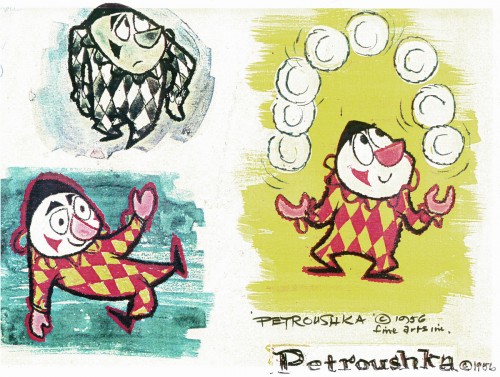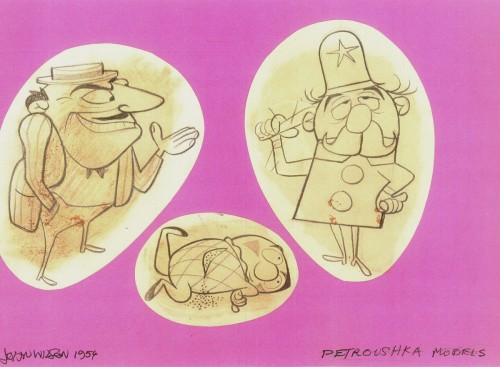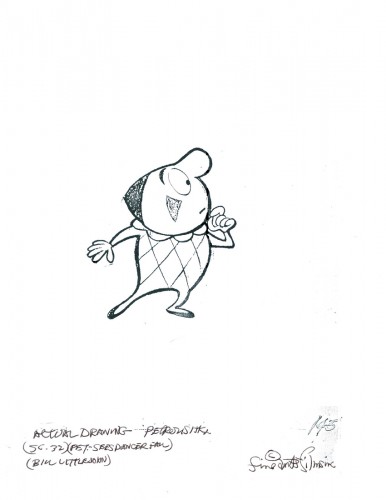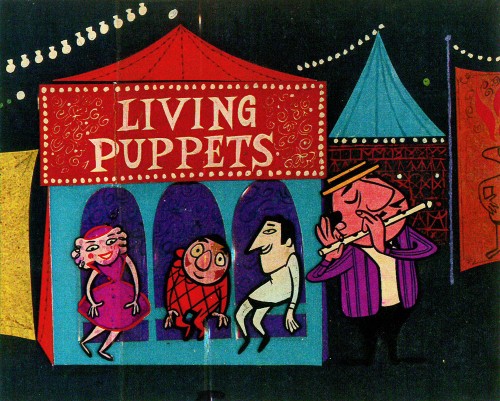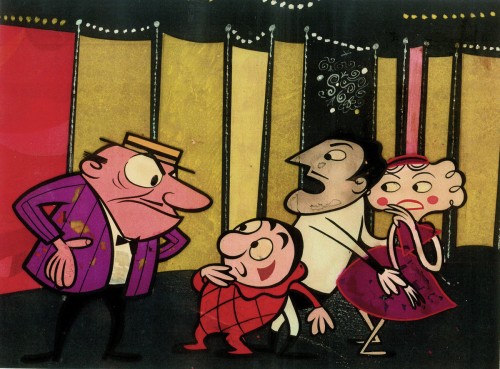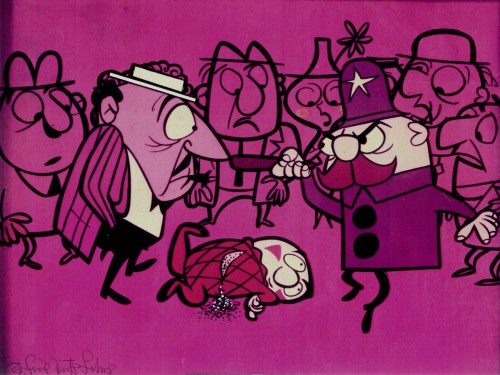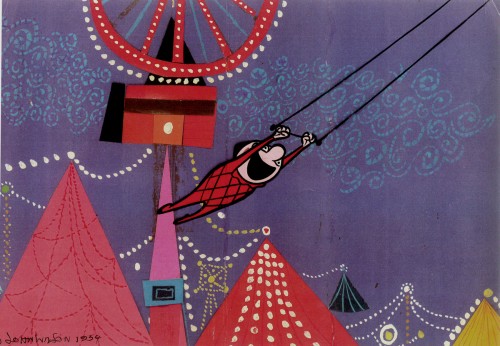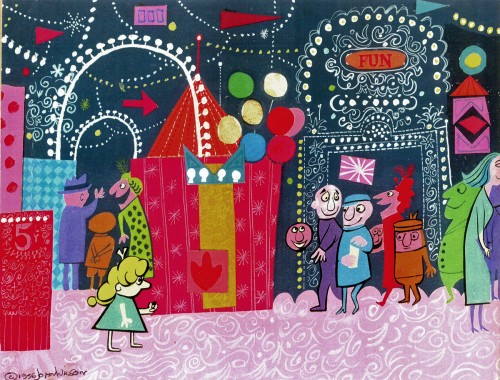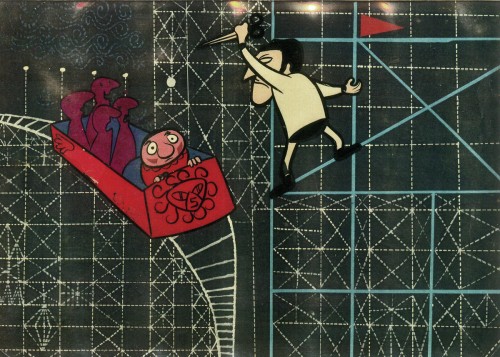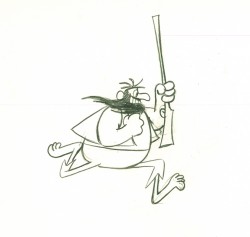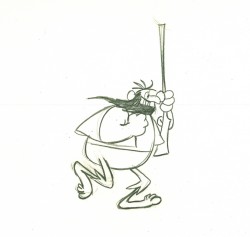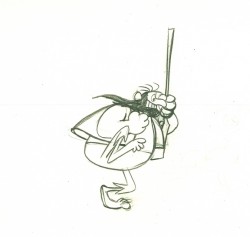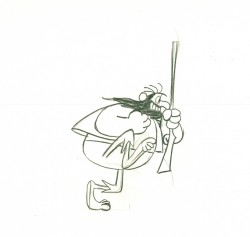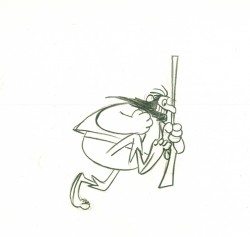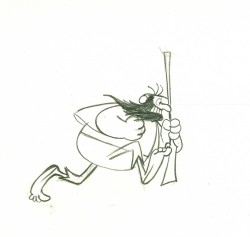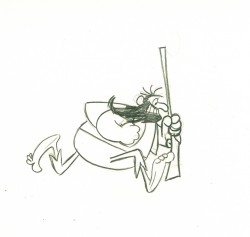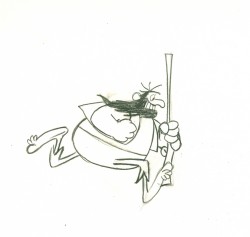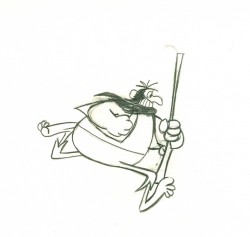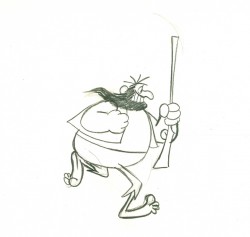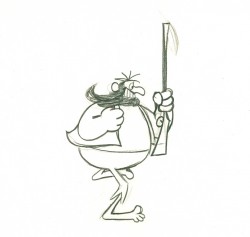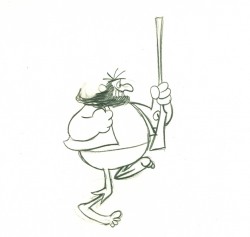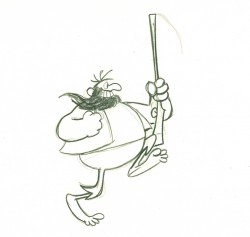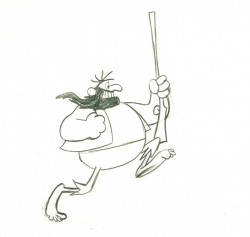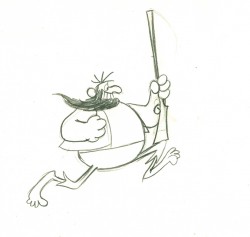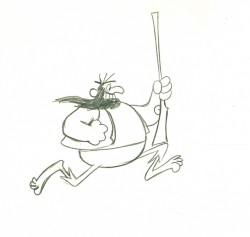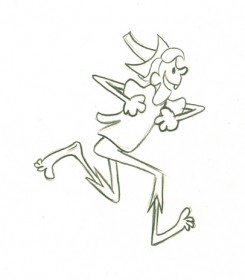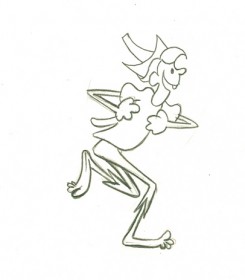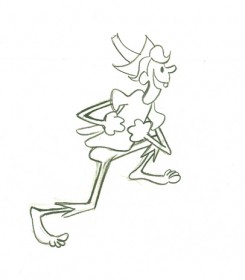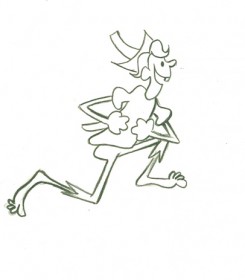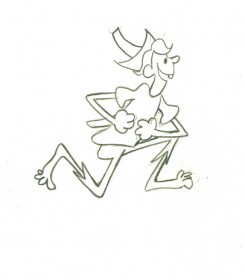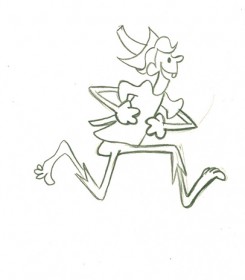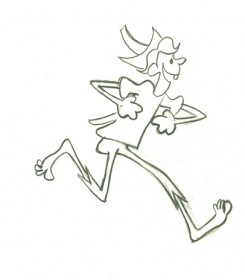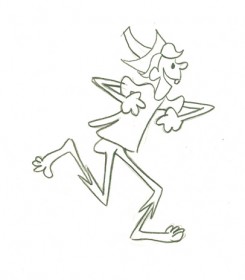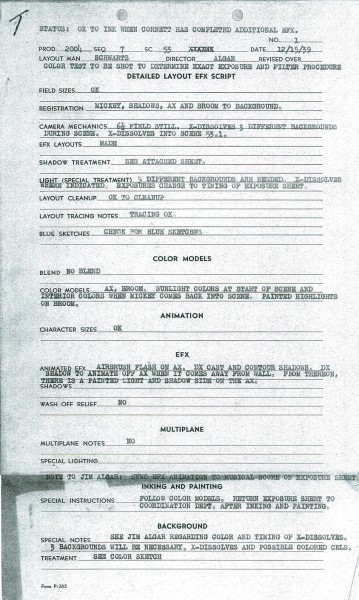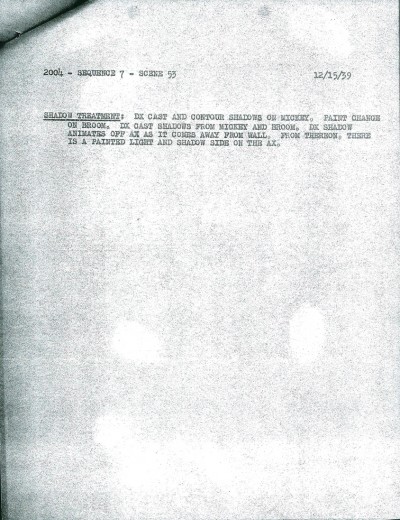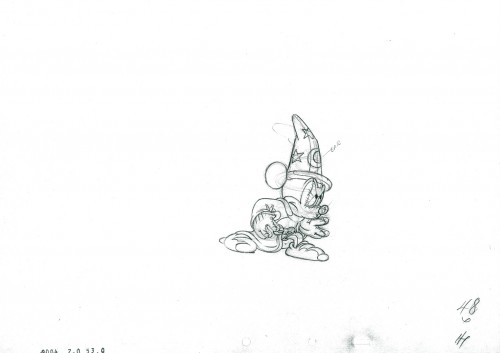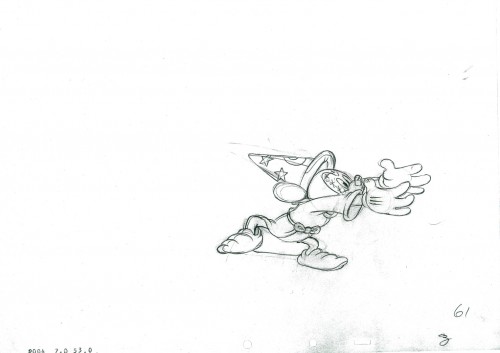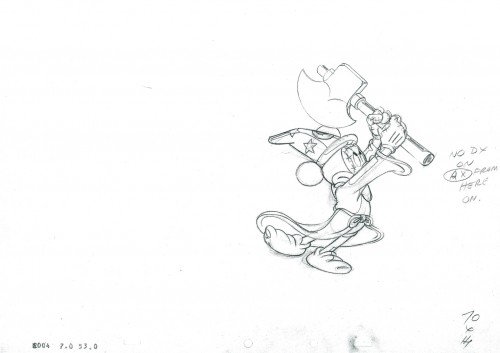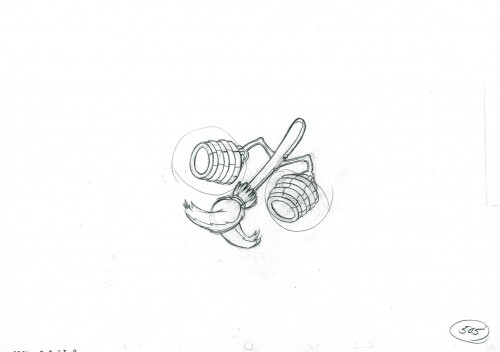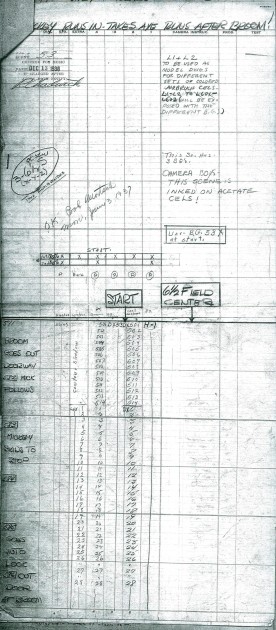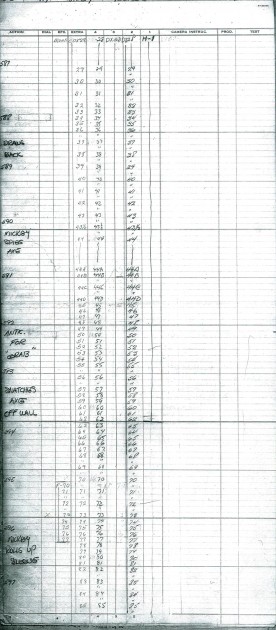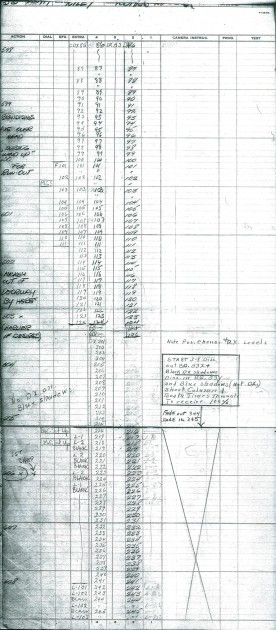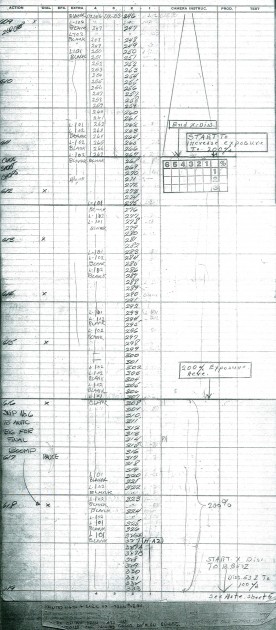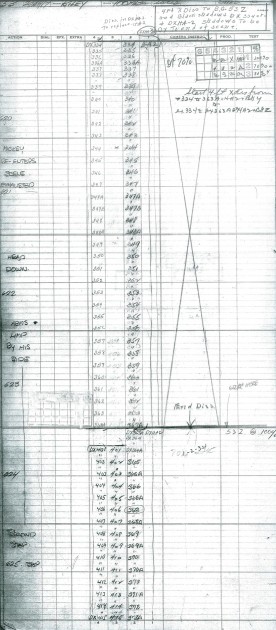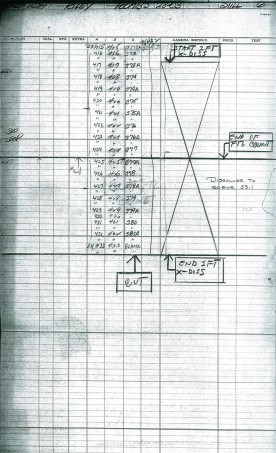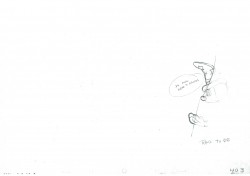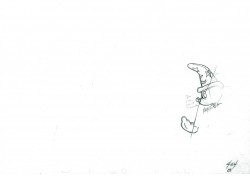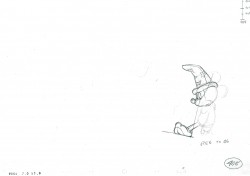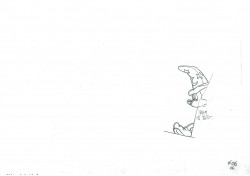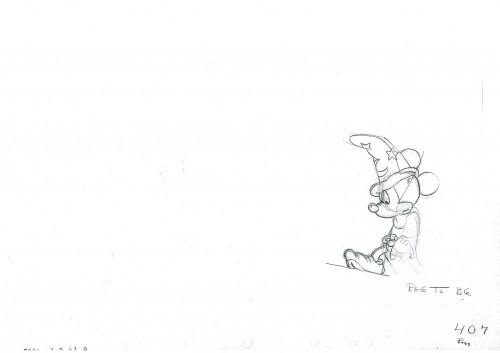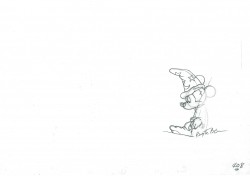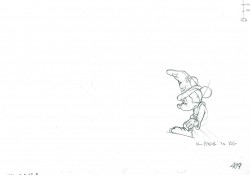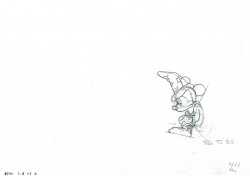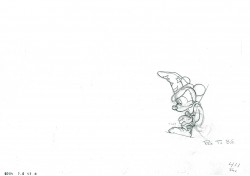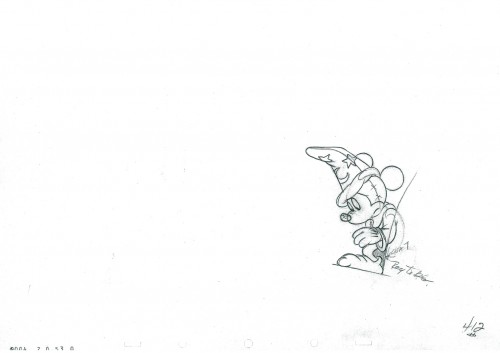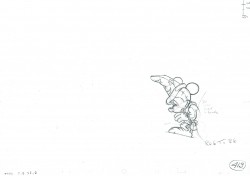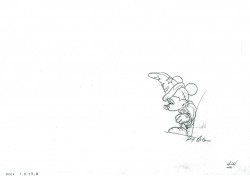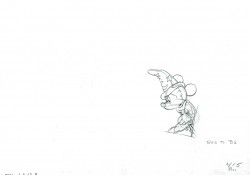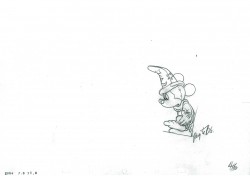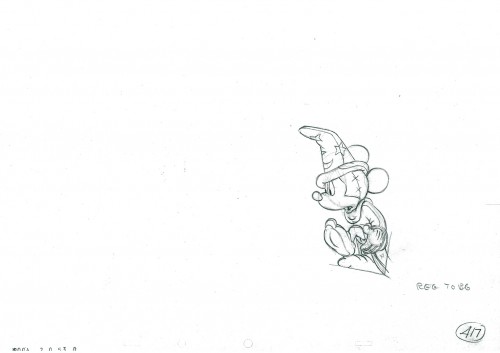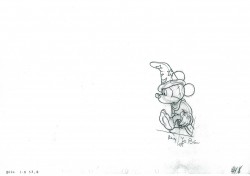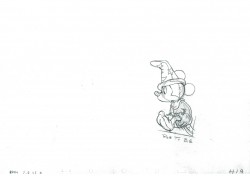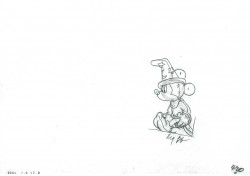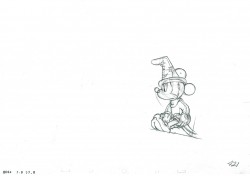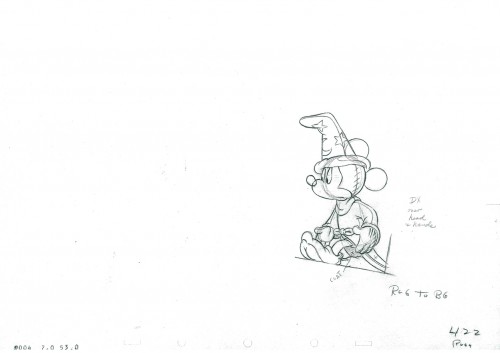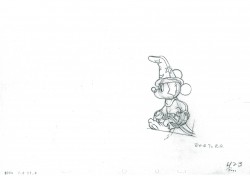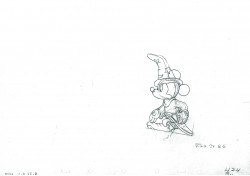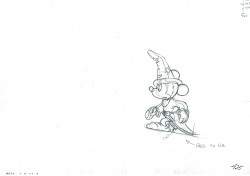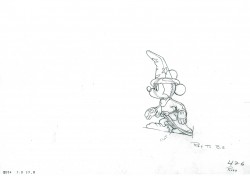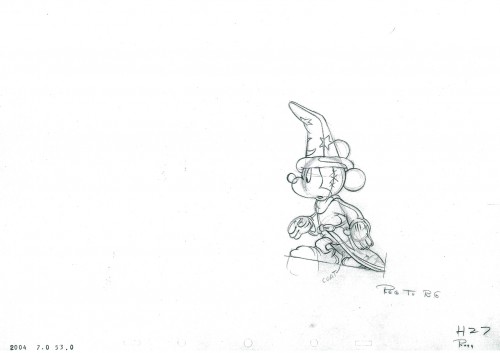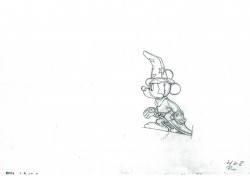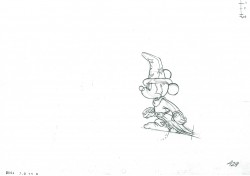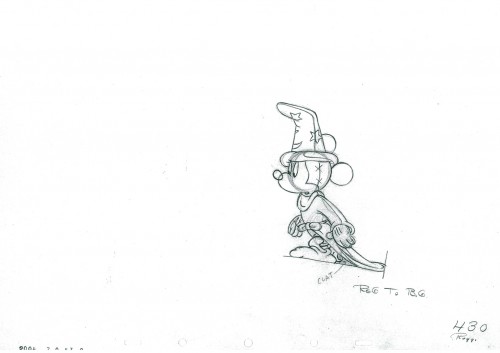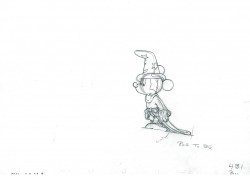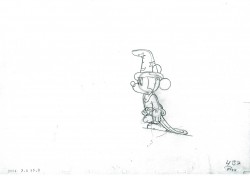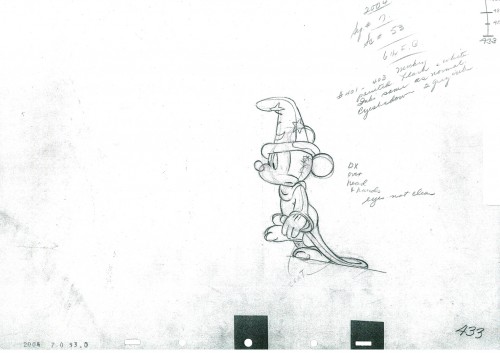Category ArchiveAnimation
Animation &Animation Artifacts &Disney 15 Feb 2012 06:43 am
Roger’s Song – part 1
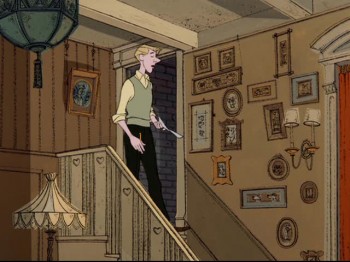
- In 101 Dalmatians, Roger sings the song, “Cruella de Vil,” immediately after Cruella leaves the house. I have three of Milt Kahl‘s scenes from this song, and I’ll post all three. We start with Roger on the stairs coming down from his upstairs studio. You’ll remember that he actually started the song upstairs, making a racket, to force Cruella to leave. Here we go with Seq. 02 Sc. 15, animated by Milt Kahl.
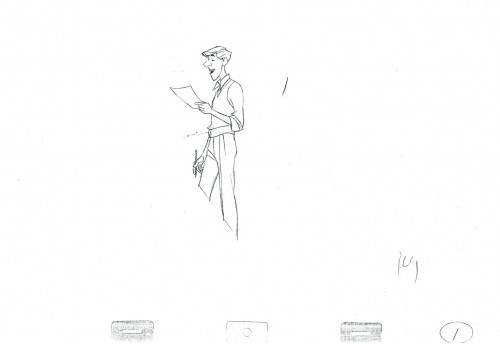 01
01
______________________
The following QT includes the drawings posted above.
The registration is a bit loose. Sorry but, these are copies of
copies and there’s plenty of shrinkage.
If you click on the right side of the lower bar
you can watch it one frame at a time.
Animation &Animation Artifacts &Disney 08 Feb 2012 07:24 am
Roger – Scene 45 – part 3
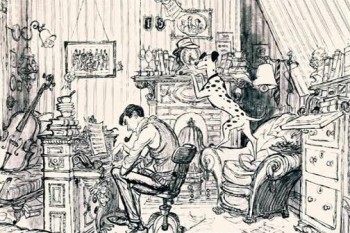 - Here is the final part of Scene 45 from 101 Dalmatians as animated by Milt Kahl. When this scene was loaned to me, it took less than a mezzo second for me to recognize it. I love it and have studied it frame-by-frame off the video (first a VHS then the DVD) many times. It’s a seminal scene for me. Just gorgeous.
- Here is the final part of Scene 45 from 101 Dalmatians as animated by Milt Kahl. When this scene was loaned to me, it took less than a mezzo second for me to recognize it. I love it and have studied it frame-by-frame off the video (first a VHS then the DVD) many times. It’s a seminal scene for me. Just gorgeous.
I’ve always loved the first fifteen to twenty minutes of Disney features (at least up
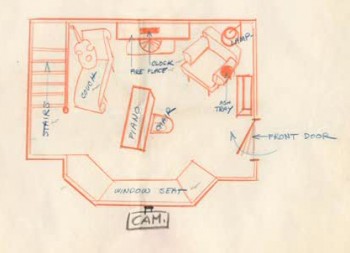 through Sword in the Stone.) Their intelligent introductions of principal characters usually comes in those first few minutes, and it’s always done with class. I think of Pinocchio, Gepetto, and Jiminy Cricket or Dumbo’s birth or Lady as a puppy or Bambi’s birth and discovering the world of the forest or Peter and Tink meeting the Darling children and “Off to Neverland.” These moments are thrilling to me, and usually the rest of the film doesn’t hold up to this.
through Sword in the Stone.) Their intelligent introductions of principal characters usually comes in those first few minutes, and it’s always done with class. I think of Pinocchio, Gepetto, and Jiminy Cricket or Dumbo’s birth or Lady as a puppy or Bambi’s birth and discovering the world of the forest or Peter and Tink meeting the Darling children and “Off to Neverland.” These moments are thrilling to me, and usually the rest of the film doesn’t hold up to this.
101 Dalmatians doesn’t fail to deliver in this respect. Exposition and introduction are done so beautifully.
The animation is, for the most part, on twos. There are a couple of ones at the very end ot the scene as Roger shakes his wrist. If you want to visit the first two parts go here for Part 1 or here for Part 2.
We start today with the last drawing from the second post.
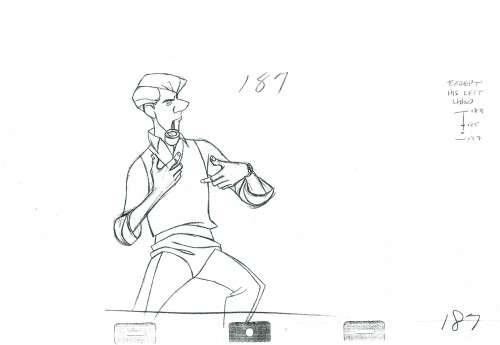 187
187
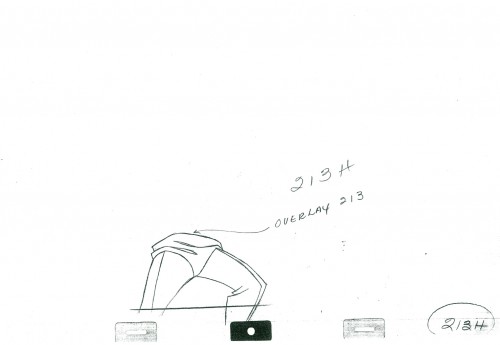 213H
213H
The legs move to their own level at this point.
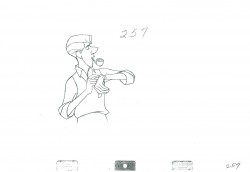
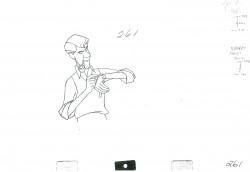
A drawing is skipped here (to be inbetweened.)
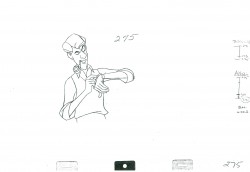
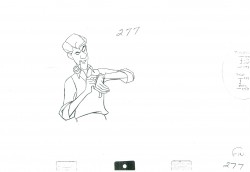
A drawing is skipped, needs inbetweening.
______________________
The following QT includes the entire sequence
which includes all drawings posted.
The registration is a bit loose. Sorry but, these are copies of
copies and there’s plenty of shrinkage.
If you click on the right side of the lower bar
you can watch it one frame at a time.
.
For more on 101 Dalmatians check out the animator drafts on Hans Perk‘s great and resourceful site, A Film LA. Hans has also posted Bill Peet‘s story treatment for the film several years ago. See it here.
For a look at the art direction of the film including some beautiful reconstructions of the BGs as well as some of the BG layouts go to Hans Bacher‘s great site One1More2Time3.
Andreas Deja has one of the more extraordinary blogs to visit. He just posted some beautiful drawings by some of the key animators on 101 Dalmatians as they set about to find the characters. See them here as well as a comparison of Milt Kahl‘s characters against Bill Peet‘s version. here
For those who own Fraser MacLean‘s excellent book, Setting the Scene, you’ll know that on pages 182-188 there’s an extensive discussion of this opening sequence from the film with plenty of beautiful images of the set.
Animation &Commentary &commercial animation &Independent Animation &repeated posts 06 Feb 2012 06:49 am
John Wilson – part 5
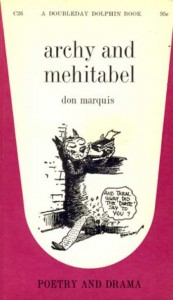 - Don Marquis‘ book, Archy and Mehitabel, garnered fame quickly and not least because of the extraordinary illustrations of George Herriman, the creator of Krazy Kat.
- Don Marquis‘ book, Archy and Mehitabel, garnered fame quickly and not least because of the extraordinary illustrations of George Herriman, the creator of Krazy Kat.
The first book was published in 1927 and others followed in 1933 and 1935. It wasn’t until the third book that Herriman took over the characters created by Marquis in his book of short stories, developed mostly, in poetry. An on-again off-again love affair, the story had two principal characters: a cat, Mehitabel, and Archy, cockroach. (You can read these poems on line here.)
In 1953, writer Joe Darion along with composer George Kleinsinger (the creator of Tubby the Tuba) wrote a musical theater piece. Tenor Jonathan Anderson played Archy and soprano Mignon Dunn was Mehitabel. At about the same time a recording of the showtunes was recorded with Carol Channing as Mehitabel and Eddie Bracken as Archy. The record was a success.
With the help of the young writer, Mel Brooks, they were able to get their show to Broadway in 1957, but it was now named Shinbone Alley. After 49 performances, the show closed, but the original cast album was recorded that same year. The songs stayed in the permanent repetoire of Carol Channing and Eartha Kitt.
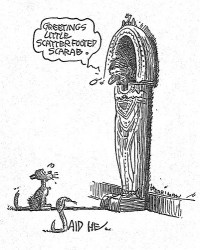 In 1971, John Wilson directed an animated feature starring the voices of Channing and Brackett and using the songs from the musical. The love affair between Archy and Mehitabel was penned by Archy, the cockroach; his poems tell their story.
In 1971, John Wilson directed an animated feature starring the voices of Channing and Brackett and using the songs from the musical. The love affair between Archy and Mehitabel was penned by Archy, the cockroach; his poems tell their story.
The film suffers from its music. The songs are simple and sound as if they’re written for children, but the lyrics pull from the poems which are definitely designed for adults. It gets a bit confusing, as a result, and is a bit picaresque; the poems are short and illustrating them in animation would take more adaptation than seen here.
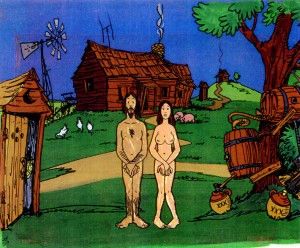 John Wilson had developed his studio, Fine Arts Films, on the back of the weekly, animated, music videos he did for The Sonny and Cher Show, an enormous hit in the early 70s.
John Wilson had developed his studio, Fine Arts Films, on the back of the weekly, animated, music videos he did for The Sonny and Cher Show, an enormous hit in the early 70s.
These music videos were loose designs animated quickly and lively around the songs Sonny & Cher would schedule each week. There would always be one or two of these pieces, and they were highlights in the weekly one-hour musical/variety program.
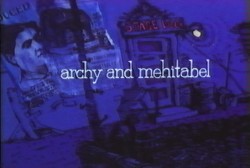 The graphics of Shinbone Alley aren’t too far from these Sonny & Cher videos. Loose design and animation with a design style not too far from the Fred Wolf’s made-for-ABC feature, The Point. This was the first feature made for television and featured the songs and story of Harry Nilsson, although Shinbone Alley featured a wilder color pallette.
The graphics of Shinbone Alley aren’t too far from these Sonny & Cher videos. Loose design and animation with a design style not too far from the Fred Wolf’s made-for-ABC feature, The Point. This was the first feature made for television and featured the songs and story of Harry Nilsson, although Shinbone Alley featured a wilder color pallette.
Jules Engel, Corny Cole and Sam Cornell all worked in design on the film. The long list of 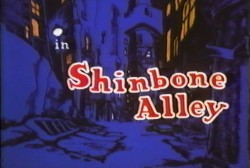 animators included Barrie Nelson, John Sparey, Spencer Peel, Eddie Rehberg and Jim Hiltz. Mark Kausler was an assistant on the show.
animators included Barrie Nelson, John Sparey, Spencer Peel, Eddie Rehberg and Jim Hiltz. Mark Kausler was an assistant on the show.
The film wasn’t an enormous success, but that was probably explained much by the limited distribution and the poor marketing of the film. I saw the film when it came out; I was living in Washington DC at the time (in the Navy). I was very disappointed. The animation is very limited and the style was a real let-down having known the George Herriman illustrations from the Don Marquis book. We’d already seen those limited animation Krazy Kat cartoons from King Features, so I knew the style could be done adequately – even on a budget. The style in this film just seemed a little too Hollywood cute, at the time, and it felt dated when it came out. I don’t feel too differently about it watching the VHS copy I own.
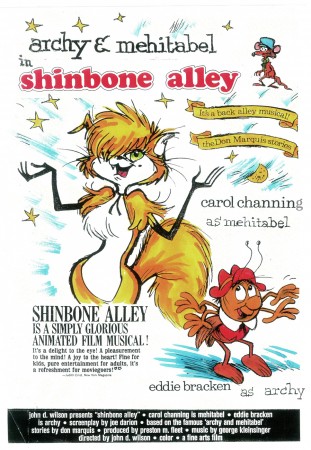
the film’s poster
Here are some frame grabs from the first 1/4 of the film:
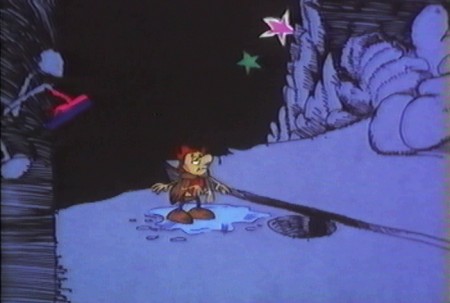
We’re introduced to Archy right off the bat as he
flies out of the river onto the dock. He realizes that he,
the poet, tried to kill himself and was sent back as a cockroach.
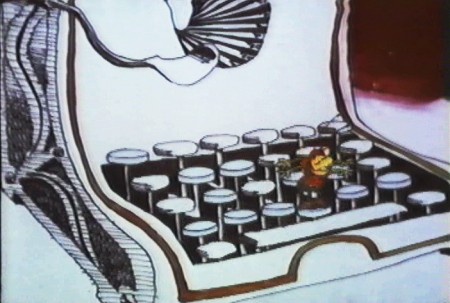
He soon finds a typewriter and goes straight back to work.
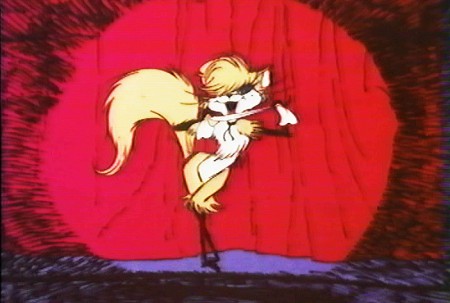
Mehitabel is a performer – with Carol Channing’s voice.
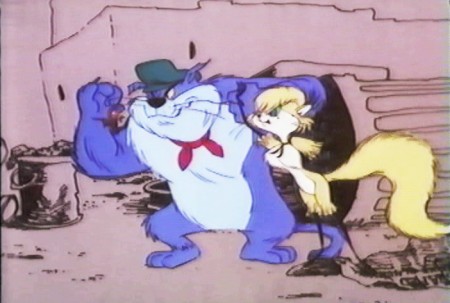
She has another boyfriend, voiced by Alan Reed,
who is also the voice of Fred Flintstone.
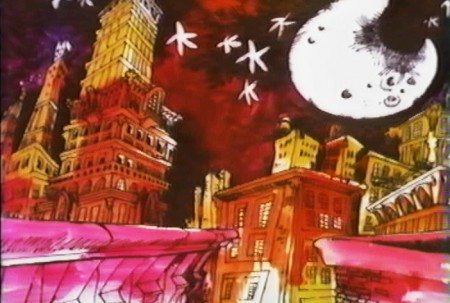
A song video takes us outside.
Part of this post was originally on this Blog in February 2010.
Animation &Animation Artifacts &Disney &Layout & Design 01 Feb 2012 07:47 am
Roger – Scene 45 -part 2
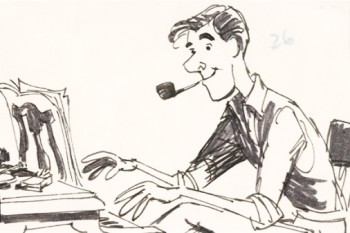 - Here is the second part of this scene from 101 Dalmatians. Roger is at the piano; Pongo has moved the mantle clock ahead by a ½ hour. Roger turns, yawns and checks his watch against the clock.
- Here is the second part of this scene from 101 Dalmatians. Roger is at the piano; Pongo has moved the mantle clock ahead by a ½ hour. Roger turns, yawns and checks his watch against the clock.
Milt Kahl animated Roger. Bill Peet did the storyboard drawing to the right. (In fact, he did the entire storyboard by himself.) This is the first of four scenes, I’ll post here – Sequence 1 Scene 45. The animation is, for the most part, on twos. There are a couple of ones at the very end ot the scene as Roger shakes his wrist. (Much of the rest of that will come with the conclusion, next week.
We start today with the last drawing from the first post.
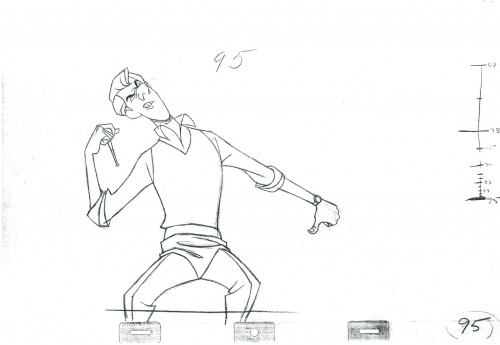 95
95
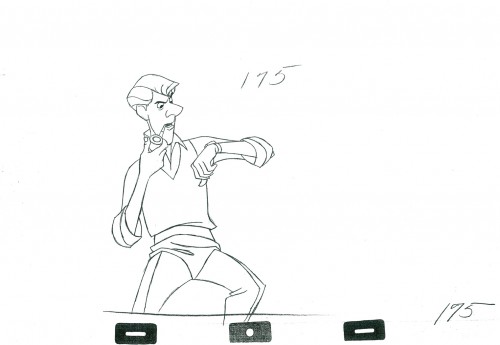 175
175
An inbetween is missing from this part.
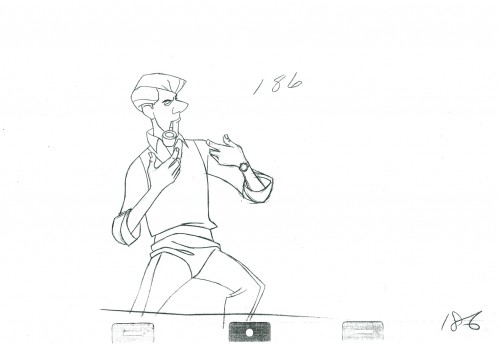 186
186
The goes on ones for a few frames as Roger shakes his wrist.
______________________
The following QT incorporates all the drawings from
this post and those in Part 1 as well.
All posts will be combined in the final piece.
All drawings were exposed on twos unless indicated otherwise.
The registration is a bit loose. Sorry but, these are copies ofcopies and there’s plenty of shrinkage.
Completion of the scene will come next week.
.
For more on 101 Dalmatians check out the animator drafts on Hans Perk‘s great and resourceful site, A Film LA. Hans has also posted Bill Peet‘s story treatment for the film several years ago. See it here.
For a look at the art direction of the film including some beautiful reconstructions of the BGs as well as some of the BG layouts go to Hans Bacher‘s great site One1More2Time3.
Andreas Deja has one of the more extraordinary blogs to visit. He just posted some beautiful drawings by some of the key animators on 101 Dalmatians as they set about to find the characters. See them here as well as a comparison of Milt Kahl‘s characters against Bill Peet‘s version. here
For those who own Fraser MacLean‘s excellent book, Setting the Scene, you’ll know that on pages 182-188 there’s an extensive discussion of this opening sequence from the film with plenty of beautiful images of the set.
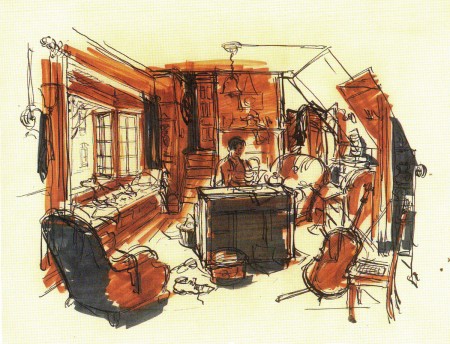
Ken Anderson’s sketch of the room.
Animation &Animation Artifacts &Disney 25 Jan 2012 07:42 am
Roger Sc 45 – part 1
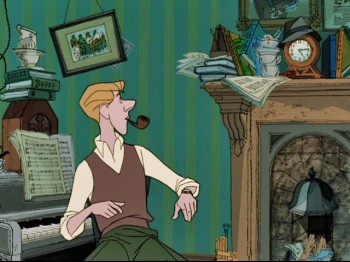 - Did I ever tell you that I love 101 Dalmatians? This film hit me hard at just the right time in my life; I was susceptible. Here was a new way of animating humans, almost a caricature but not quite. Those opening scenes of Roger playing the piano and Pongo looking out the window in search of two mates (one for him; one for Roger) are just first rate.
- Did I ever tell you that I love 101 Dalmatians? This film hit me hard at just the right time in my life; I was susceptible. Here was a new way of animating humans, almost a caricature but not quite. Those opening scenes of Roger playing the piano and Pongo looking out the window in search of two mates (one for him; one for Roger) are just first rate.
Milt Kahl did Roger, the human, and I have four scenes all used within the first fifteen minutes. They’re good. This is the first of them, Sequence 1 Scene 45. He’s turned to look at the clock, yawns and checks his watch. We’ll take it up to the yawn today. The animation is all on twos. The assistants were told to leave the line a bit rough, so some of Milt’s scratches were left to be xeroxed onto the cels.
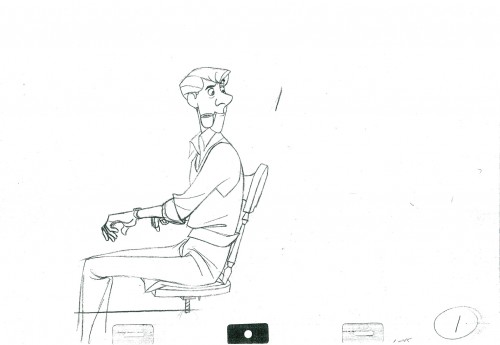 1
1
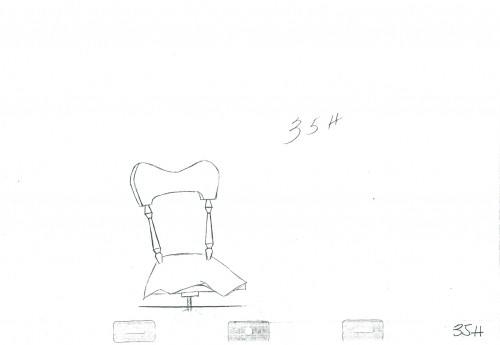 35H
35H
The chair pops to its own level behind Roger.
______________________
The following QT incorporates all the drawings from this post
All posts will be combined in the final piece.
All drawings were exposed on twos as indicated by the numbers.
The registration is a bit loose. Sorry but, these arecopies of copies and there’s some shrinkage.
More of the scene will come next week.
.
For more on 101 Dalmatians check out the animator drafts on Hans Perk‘s great and resourceful site, A Film LA. Hans also noted, in the comments section below, that he had posted Bill Peet’s story treatment for the film several years ago. See it here.
For a look at the art direction of the film including some beautiful reconstructions of the BGs as well as some of the BG layouts go to Hans Bacher‘s great site One1More2Time3.
Andreas Deja has one of the more extraordinary blogs to visit. He just posted some beautiful drawings by some of the key animators on 101 Dalmatians as they set about to find the characters. See them here.
Animation &Disney &repeated posts &walk cycle 18 Jan 2012 05:23 am
101 Dalmatians Walk Cycles
.
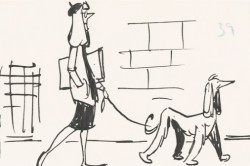 - When I was young, as I’ve pointed out many times, there were few books available about animation and as few illustrations and photos which ellicited the art of animation. Hence, it was always a treat when a Disney feature was released. The adjoining publicity would provide a trove of material, some worth saving. An encyclopedia my parents bought at about the time of release of 101 Dalmatians included several key images of Pongo running. One of those photos of many cels overlayed to detail the cycle. I loved that picture and frequently looked at that encyclopedia under “Cartoons, Animated” to study the photo of the cels.
- When I was young, as I’ve pointed out many times, there were few books available about animation and as few illustrations and photos which ellicited the art of animation. Hence, it was always a treat when a Disney feature was released. The adjoining publicity would provide a trove of material, some worth saving. An encyclopedia my parents bought at about the time of release of 101 Dalmatians included several key images of Pongo running. One of those photos of many cels overlayed to detail the cycle. I loved that picture and frequently looked at that encyclopedia under “Cartoons, Animated” to study the photo of the cels.
At the very beginning of 101 Dalmatians, Pongo looks out onto the street to search for a good mate for both himself and Roger, his owner. At this point we’re treated to a number of walk cycles that I think are brilliant. A number of women are perfectly matched to the dogs that they walk.
Now with DVDs available to us, we can see that the characters originated in the storyboard drawings, and we can study these walk cycles. I’m determined to take these animated bits apart to watch them a bit closer.
The first of these is the “girl art student” as described in the drafts (which can be found on Hans Perks’ excellent site A Film LA.) Oddly, from my very first viewing of this film back in 1961, I identified her as a “beatnik,” which was the fashionable joke back then. Now I find out she was an “art student.” I guess that makes sense.
Here’s the pan BG that this scene employs.
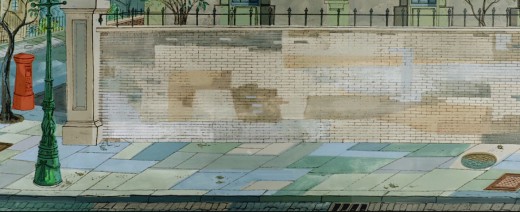
(Click any image to enlarge.)
And here is the walk cycle animated by Frank Thomas and Blaine Gibson.
Gibson handled the following scene which pans across the bodies of the pair as they walk.
Animation note: The two separate feet are divided by a short space. The left foot is on one plane, and the right foot is on another. This is a BASIC precept for animators to follow, and it’s something that is not appearing in a lot of the recent walk cycles I’ve been seeing. It’s annoying.
Here’s scene 21 “French girl walks French poodle” animated by Blaine Gibson. It employs the same BG as scene 14, the art student (posted Apr 3), but it extends, beyond what we’ve seen before, to include a telephone booth.

______________(Click any image to enlarge.)
This is a slightly faster walk than others, and I’ve been able to grab all of the drawings. It’s animated on “ones.”
This walk is an absolute gem !
Once again, check out Hans Perk‘s excellent site A Film LA to get the drafts for this film to be able to identify who was behind what. Then go to see Mark Mayerson‘s arduously constructed and informative mosaics as well as his detailed commentary about the film and its animators.
Check out Floyd Norman‘s story about Blaine Gibson on Jim Hill Media.
Here’s the young child with her puppy. She not only walks, but she licks her lollipop. The pup is just an absolute innocent. It’s another great walk by Blaine Gibson.
 1
1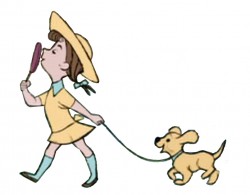 2
2
_______(Click any image to enlarge.)
The piece, in the film, includes a zoom into the cycle. I’ve tried to adjust for it but don’t think I was wholly successful. There’s a marginal enlargement of the drawings as it goes on – noticeable only in motion. It’s actually interesting in the walk.
Here’s Blaine Gibson’s animation for what is labelled in the drafts “Buxom Girl and Bulldog”. I left the backgrounds in this one for you to get an idea of the BG movement.
Animation &Animation Artifacts &Independent Animation 16 Jan 2012 06:17 am
John Wilson/Fine Art Films – part 2
- After completing the film, Tara the Stone Cutter in 1955, John Wilson and his newly formed company,Fine Arts Films, was able to sell the idea of an animated version of Stravinsky’s Petroushka to NBC. They aired the 16 min. film in 1956 as part of The Sol Hurok Music Hour. Stravinsky, himself, arranged and conducted the shortened version of the score using the LA Philharmonic Orchestra.
The film was designed by John Wilson and Dean Spille; animation was done by Bill Littlejohn, Art Davis, and Phil Monroe. Chris Jenkyns, Dean Spille and Ed DeMattia designed the show from Wilson’s storyboard. This is considered the first animated Special ever to air on TV.
Here are some stills from that film and its artwork.
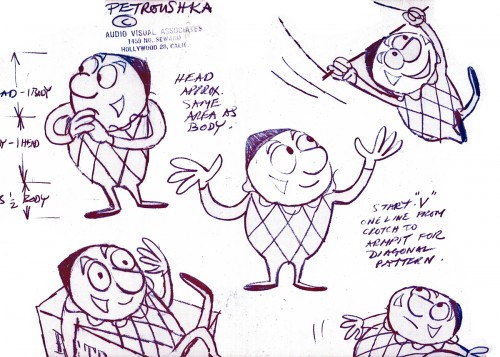 1
1Petroushka – model 1
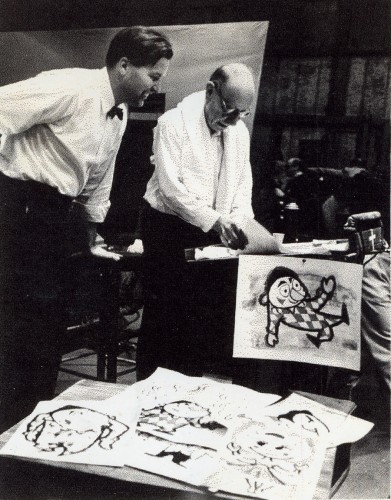 11
11
John Wilson and Igor Stravinsky preparing for recording of Petroushka
with the Los Angeles Philharmonic Orchestra (1955).
Here are copies of two reviews:
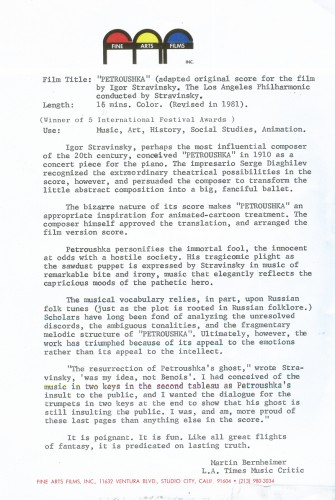
Los Angeles Time review (1956)
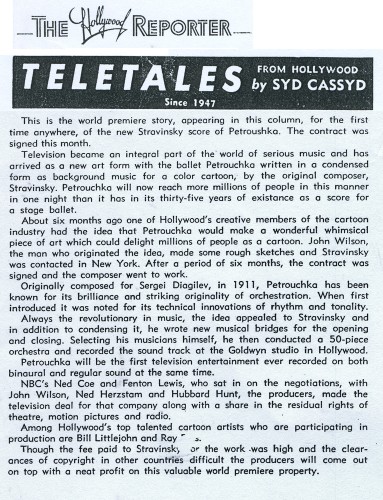
Hollywood Reporter review )1956)
(Click any image to enlarge.)
Petroushka was released on VHS tape combined with a number of the song pieces he did for the Sonny and Cher program. This tape, John Wilson’s Fantastic All Electric Music Movie, can still be found on Amazon but is pricey.
Thanks to Amid Amidi for the material.
Animation &Animation Artifacts &repeated posts &Tissa David 11 Jan 2012 06:03 am
Hillbilly Run Cycles – Grim Natwick/Tissa David
- When I first started in animation at the Hubley Studio, I met Tissa David. She recognized how poor my inbetweens were and took me under her wing to try to correct the situation. She gave me private lessons for years. Often she would give me scenes animated by her mentor, Grim Natwick, and she would ask me to remove every other drawing and do new inbetweens for what was left. When I finally got them close to being correct, she’d have me do clean-ups of Grim’s work.
These two run cycles were among the first drawings she gave me to rework. Back then, the only way to see the drawings in motion was to flip them or film them. There were no computers to see them instantaneously moving. You can just go to the bottom of each cycle, and I’ve added a QT pencil test,
I might suggest that if you’re just starting out, you should print out the drawings and then do new versions of the inbetweens for the even numbered drawings. Go back to Tissa’s versions to compare with what you did.
Grim Natwick animated this spot for Mountain Dew when he worked for Robert Lawrence Productions. Here are two run cycles from that spot. It was assisted by Tissa David. All of the drawings, here, are Tissa’s clean-ups.
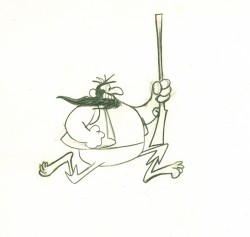 1
1 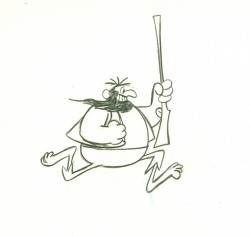 2
2
(Click any image to enlarge to full size.)
On ones at 24FPS
Click left side of bar to play.
Right side to watch single frame.
This is another run cycle from that same film. Again, all of the drawings, here, are Tissa’s clean-ups.
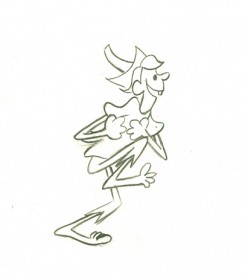 1
1 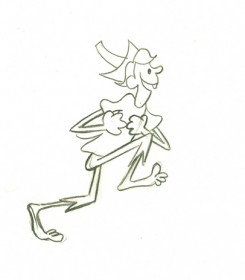 2
2
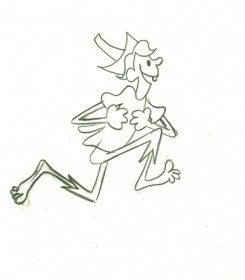 3
3 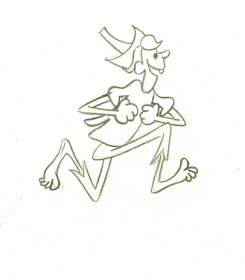 4
4
You’ll note that the character leaves the ground for 1/3 of the spot.
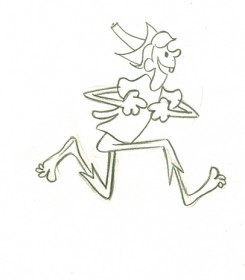 5
5 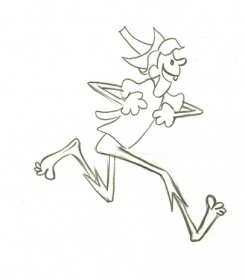 6
6
I love the chicken movement this guy is doing with his arms.
A laugh riot of a run cycle.
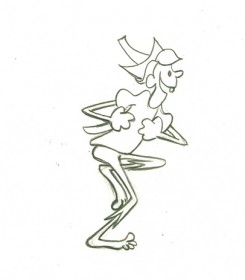 9
9 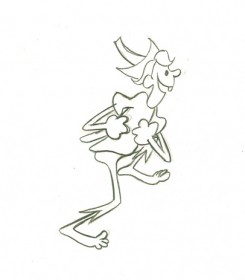 10
10
He actually comes down in the crossing position rather than the
classically designed walk where the head moves up.
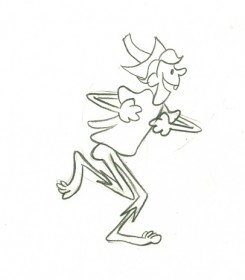 17
17 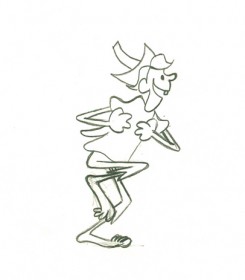 18
18
Tissa’s tendency is to have the crossing position the lowest in the cycle.
The character bears the weight of his walk with feet solidly on ground.
On ones at 24FPS
Click left side of black bar to play.
Right side to watch single frame.
This was originally posted in May 2009.
Animation &Animation Artifacts &Disney 04 Jan 2012 07:20 am
Broom X Sheets
- This post is for real animator-type geeks. To complete the posting of the scene from Fantasia of Mickey chopping the broom, I have the exposure sheets as well as some notes and that I’d like to share. If you know how to read the sheets, it’ll be informative. If you don’t, take some time to try to understand them. Although there are some complications – several dissolves and indicated effx, specifically – much of it is basic.
These are all copies of copies, so the quality isn’t the greatest.
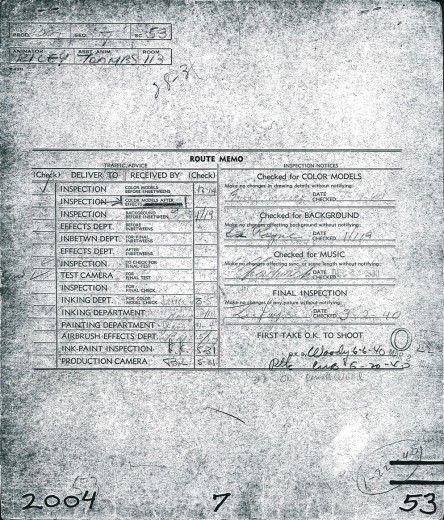
This is the cover of the folder for the scene.
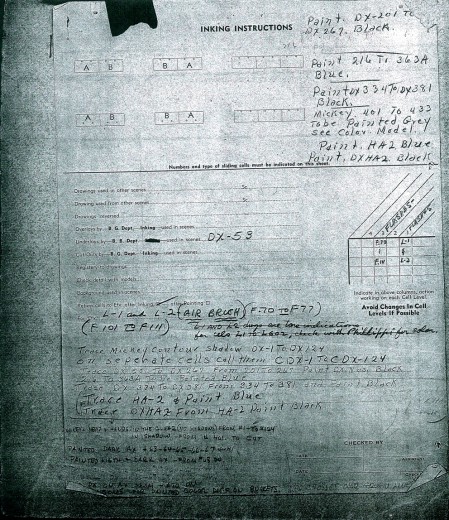
Inking instructions within the folder.
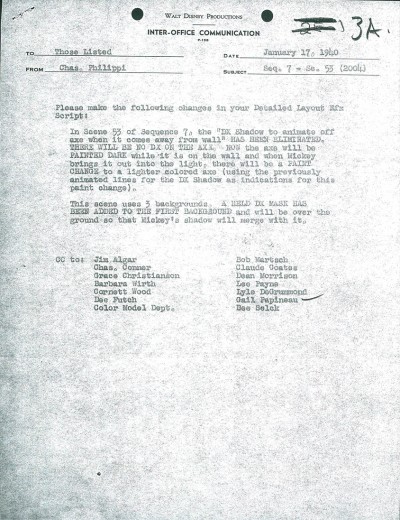
An interoffice communication about the scene.
The following are four samples of effx shading that was done
for all of Mickey and the brooms throughout the scene.
I show the original drawings followed by the effx drawing.
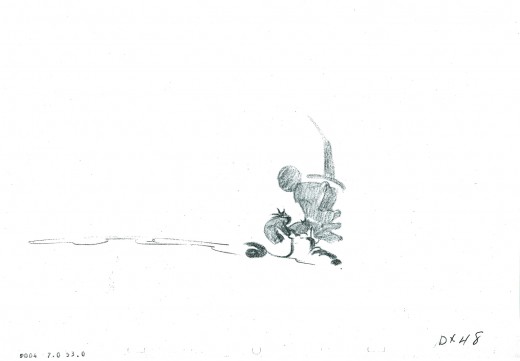
All of the effx drawings were done with a very light hand.
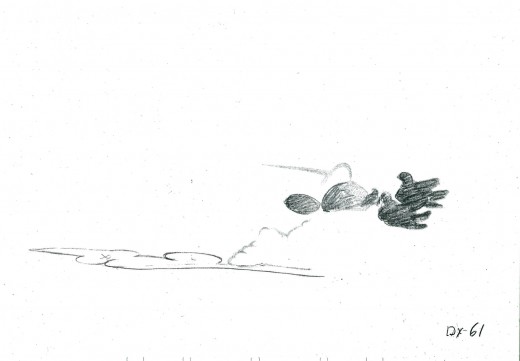
I had to push them like crazy in Photoshop so that you could see them here.
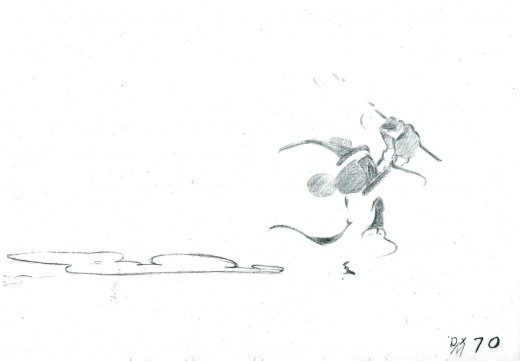
All of the Mickey & broom drawings were done this way as an
indication to the airbrush artists who would follow up.
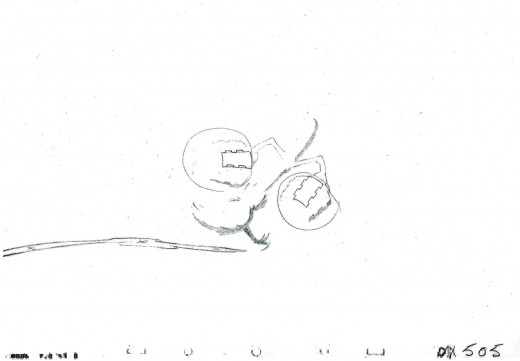
You’ll note that the scene was about to be reshot for the airbrushing.
The Exposure Sheets
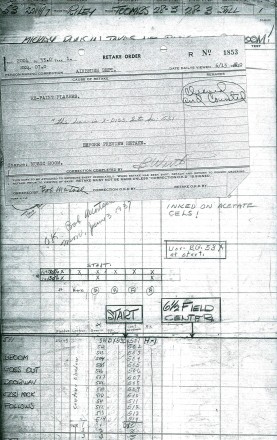
Here is a note attached to the first page of the
exposure sheets about a reshoot.
Animation &Animation Artifacts &Disney 28 Dec 2011 05:55 am
Mickey and the Brooms – part 5
- Here’s the final bit of character animation as Mickey comes out of the room having hacked the broom to splinters. He combines with some of the shadows that were posted last week.
All that’s left of the scene for me to post is the set of exposure sheets as well as some samples of the rendering for the airbrushing. Believe it or not, that’s my favorite part of the whole thing. Next week.
The scene was animated by Riley Thompson with Harvey Toombs assisting. The sequence director was James Algar.
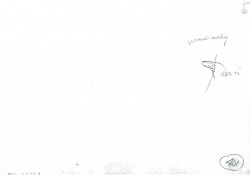
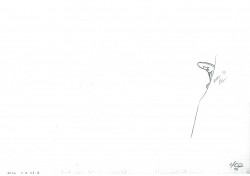 ____________________________
____________________________
The following QT incorporates all the drawings from this post
and the two earlier shadow posts.
All posts will be combined in the final piece.
All drawings were exposed per the Exposure Sheets.
this scene comes in at 5’30″
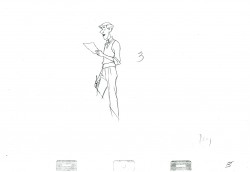
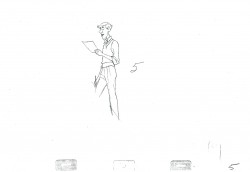
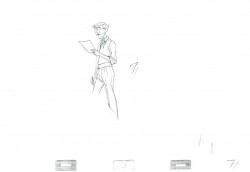
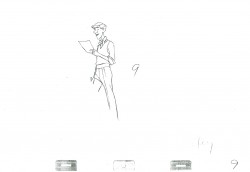
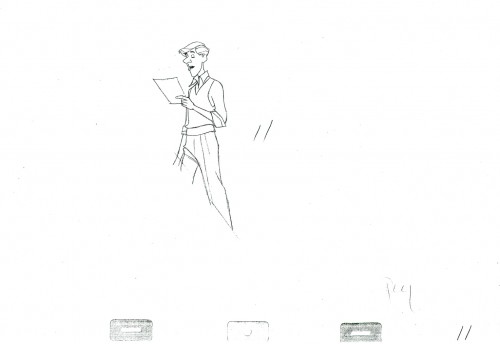
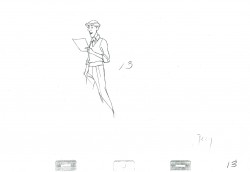
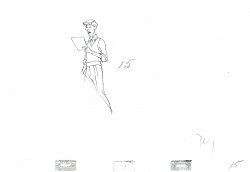
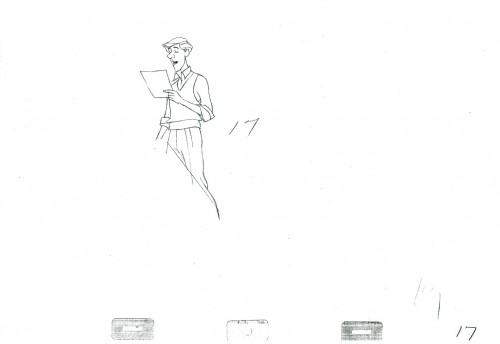
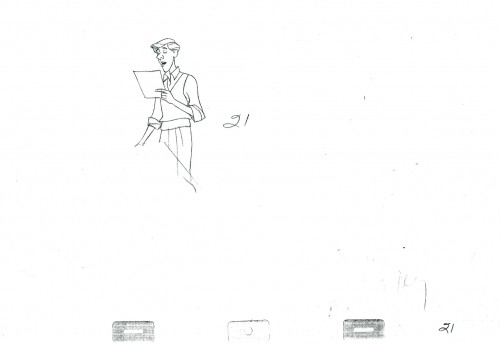
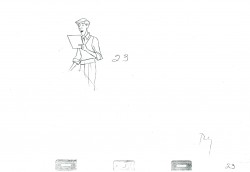
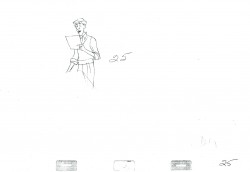
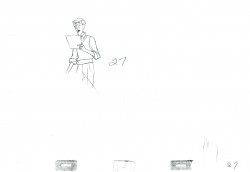
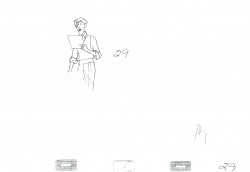
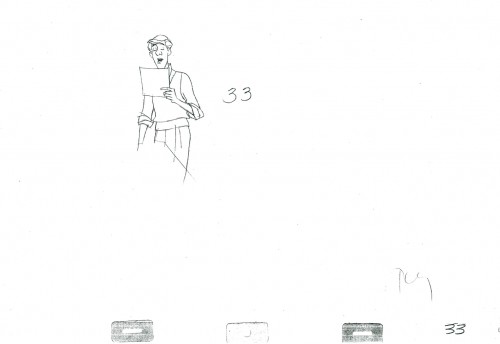
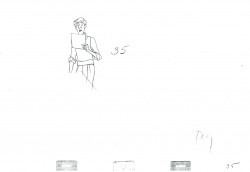
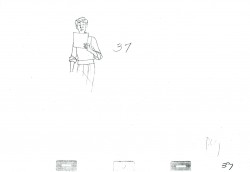
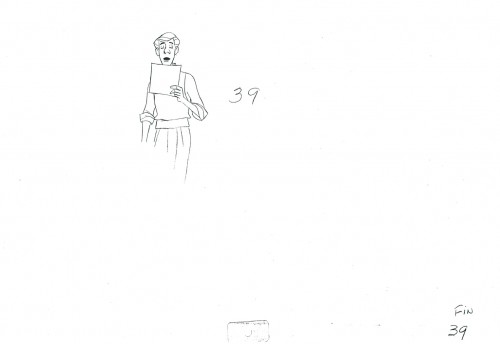
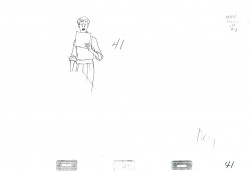
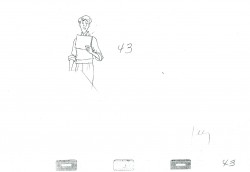
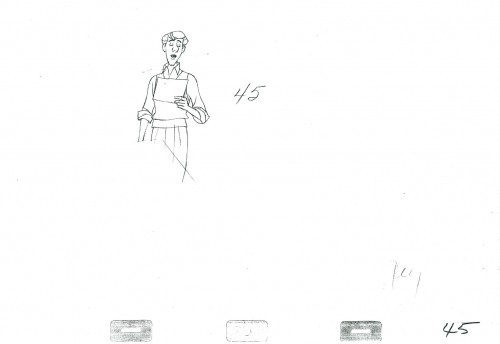
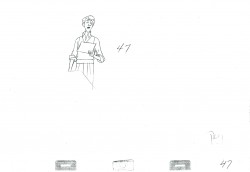
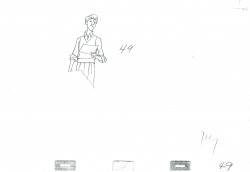
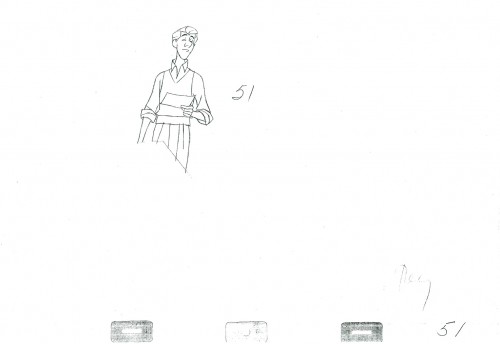
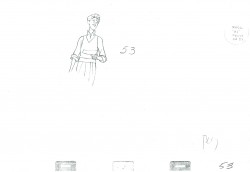
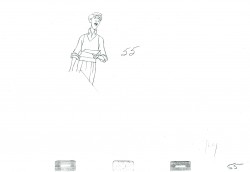
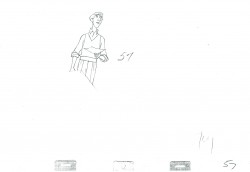
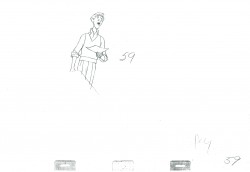
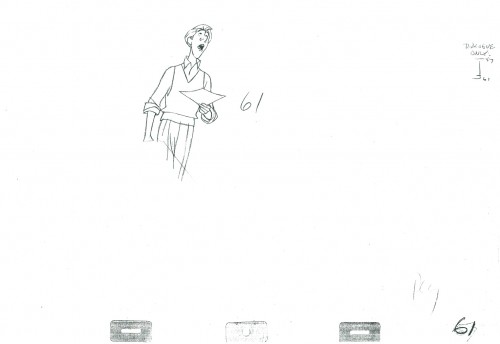
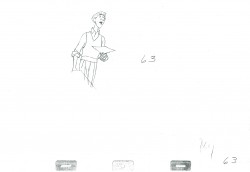
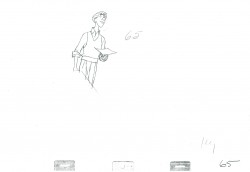
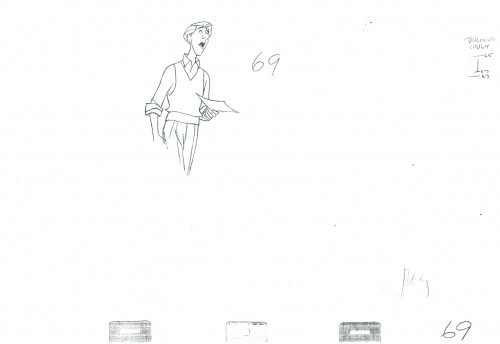
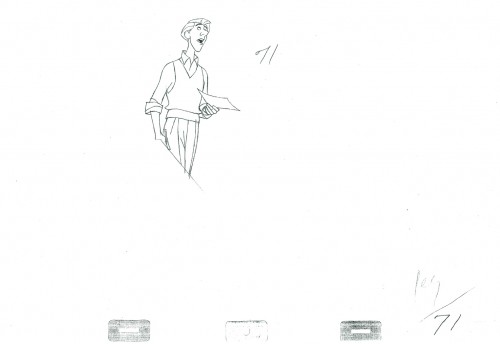
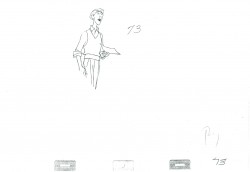
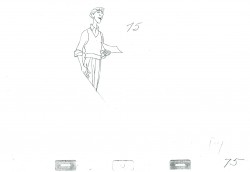
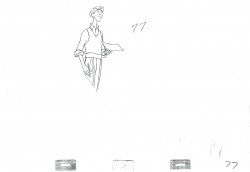
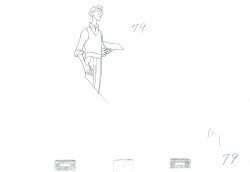
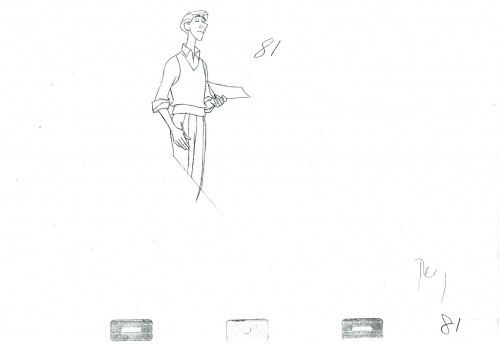
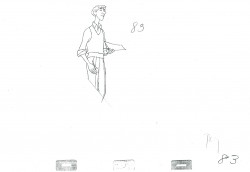
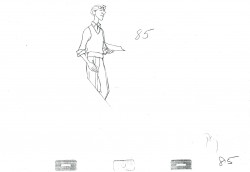
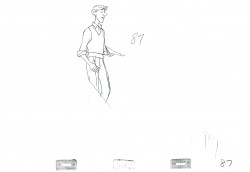
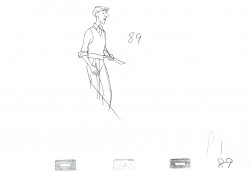
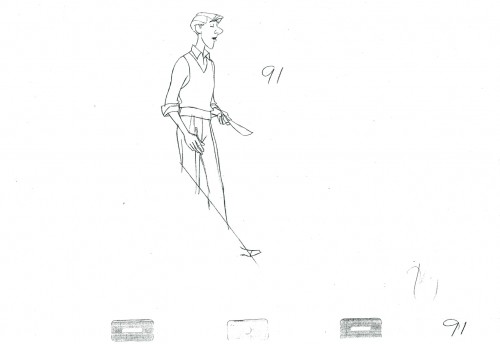
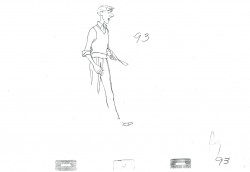
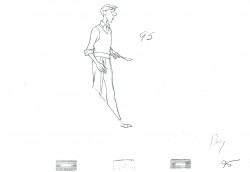
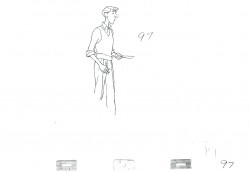
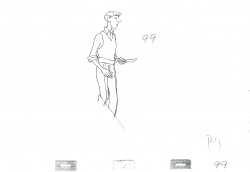
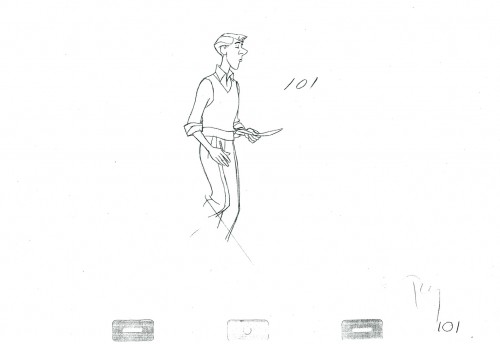
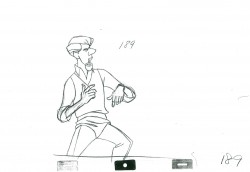
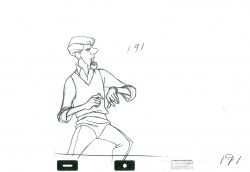
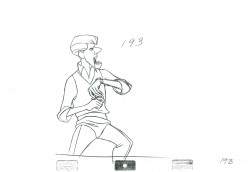
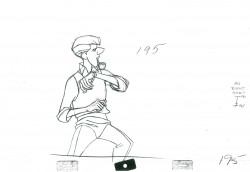
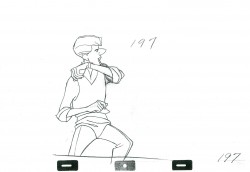
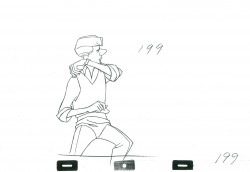
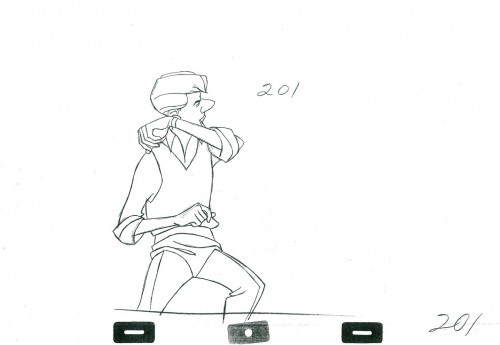
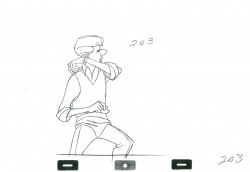
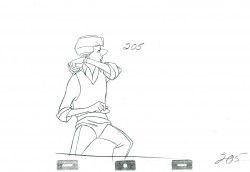
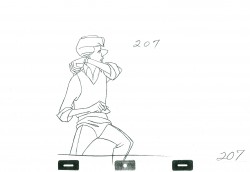
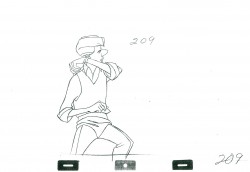
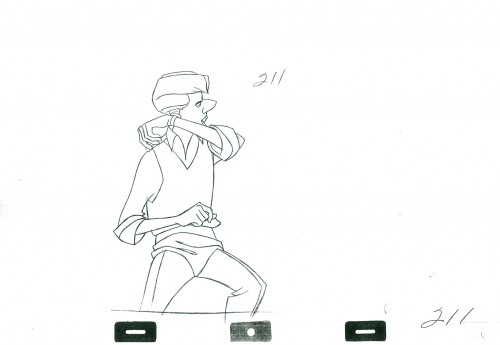
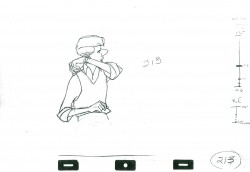
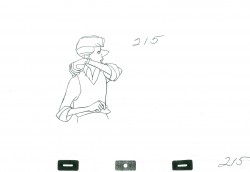
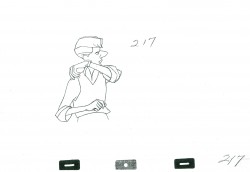
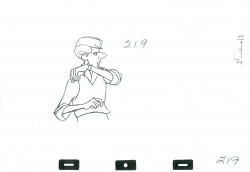
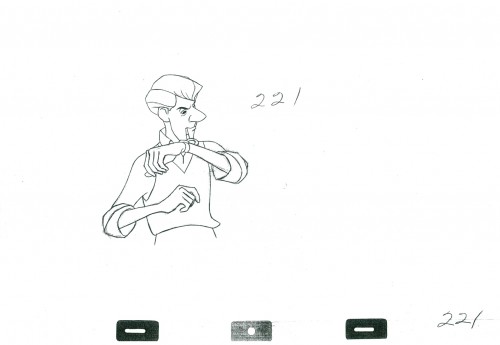
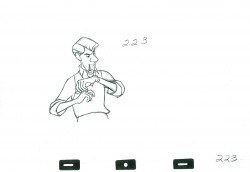
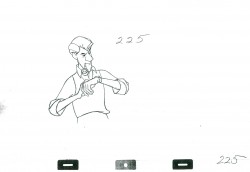
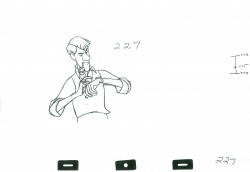
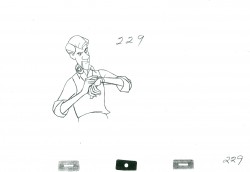
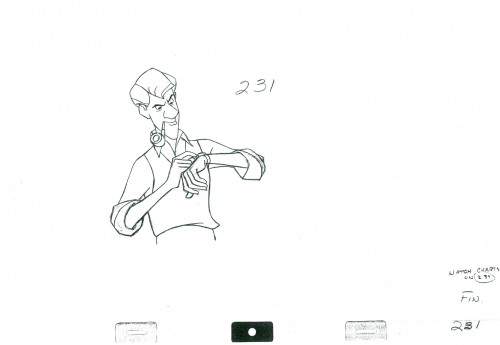
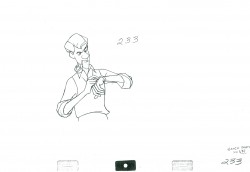
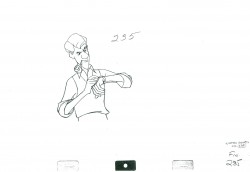
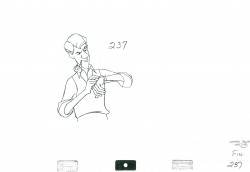
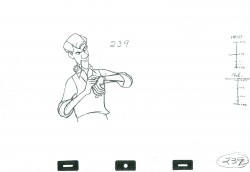
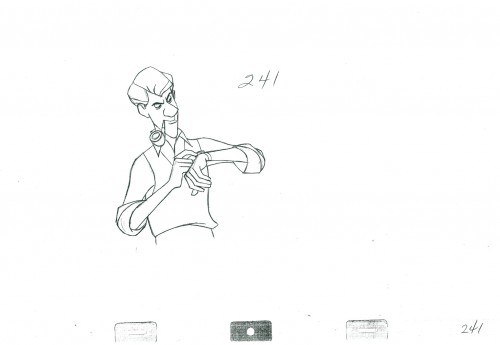
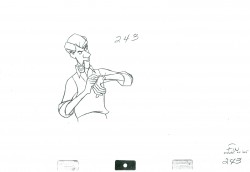
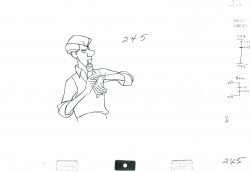
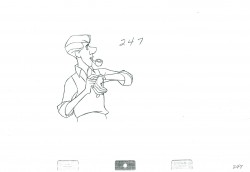
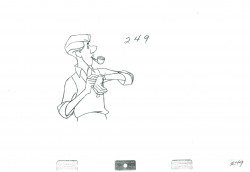
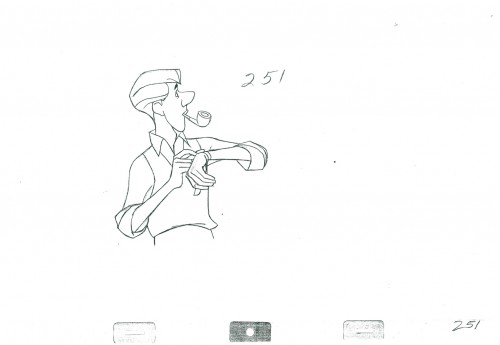
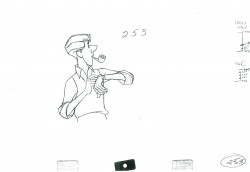
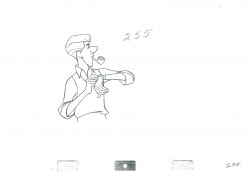
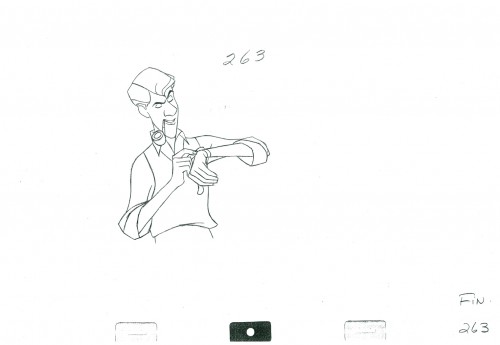
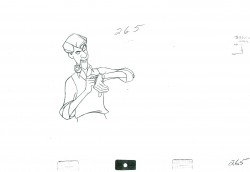
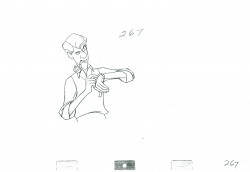
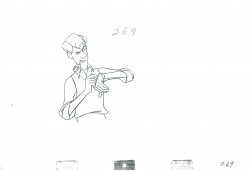
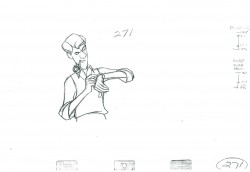
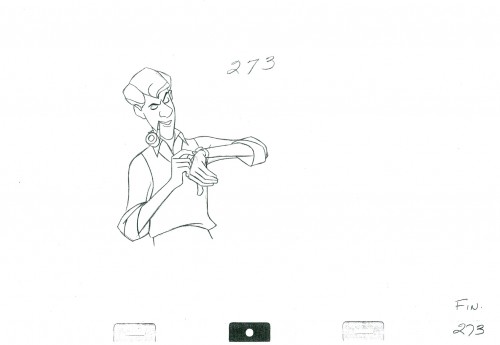
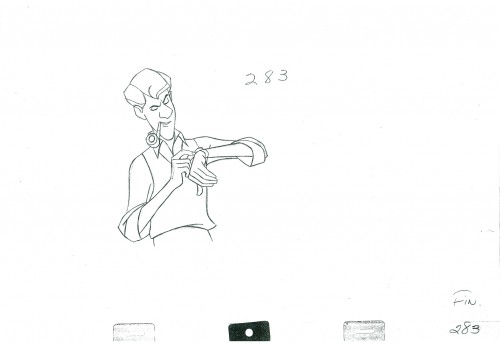
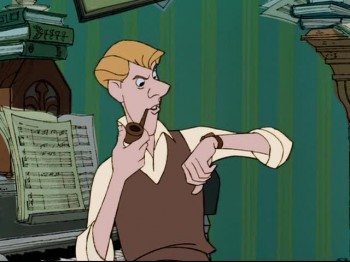
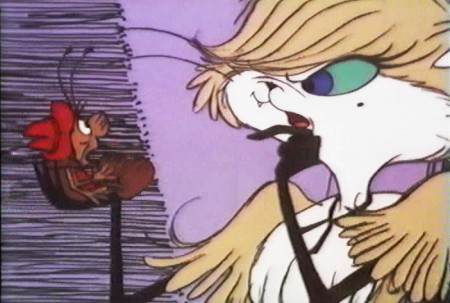
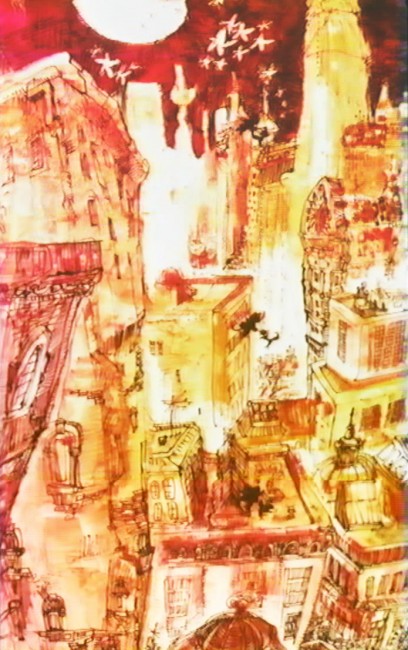
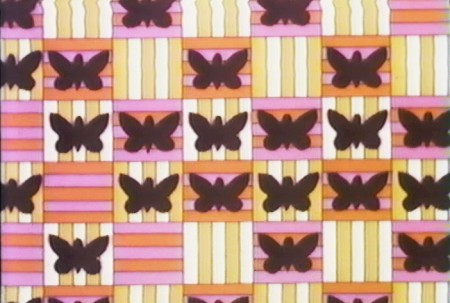
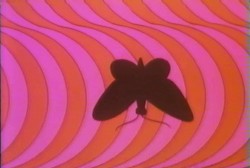
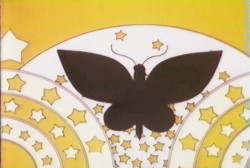
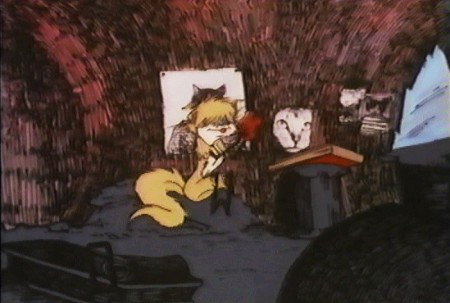
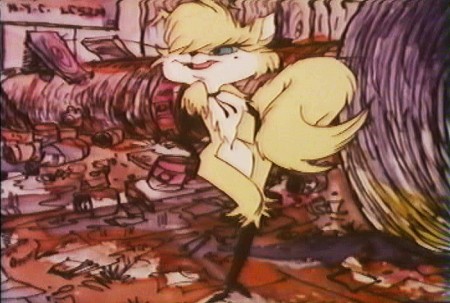
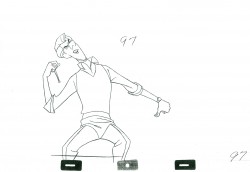
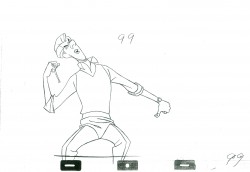
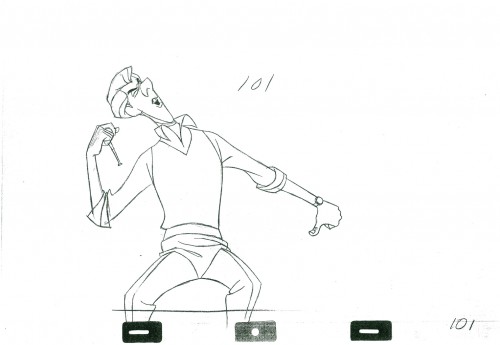
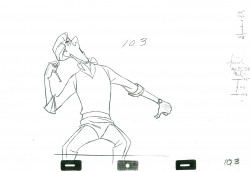
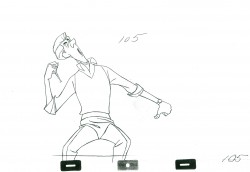
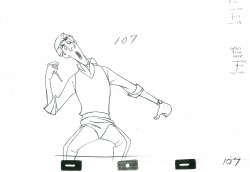
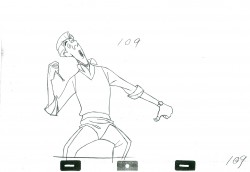
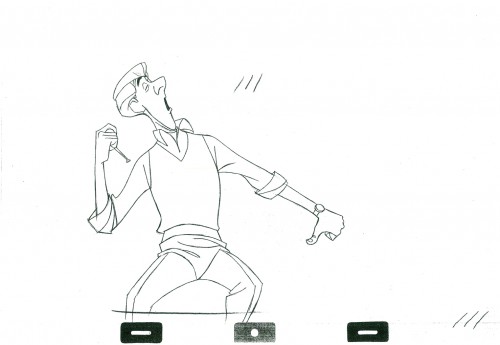
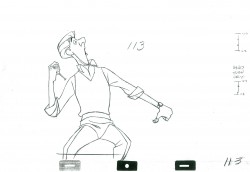
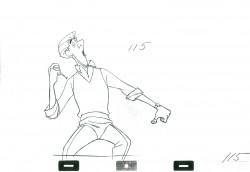
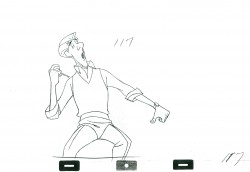
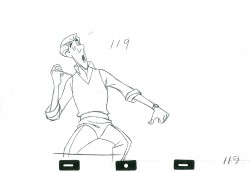
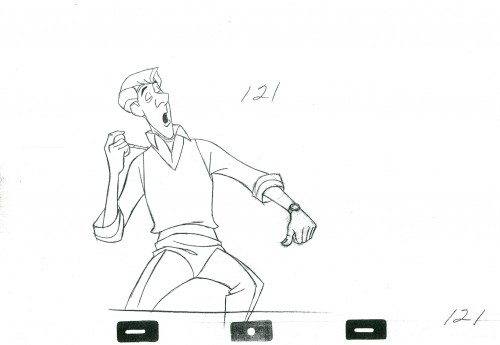
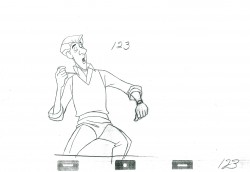
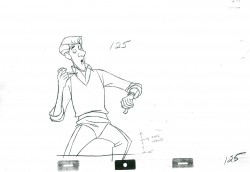
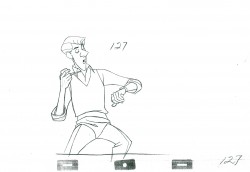
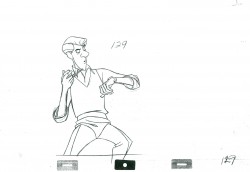
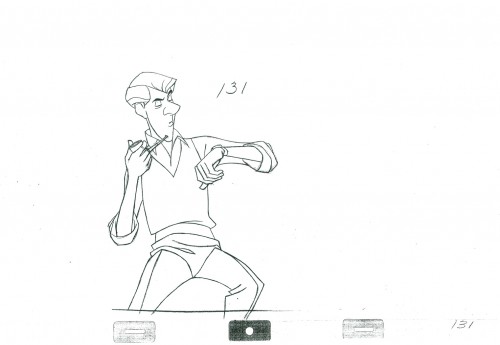
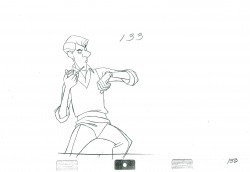
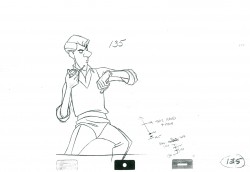
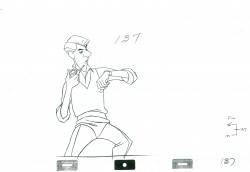
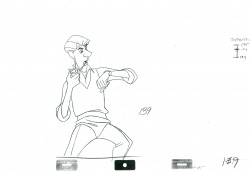
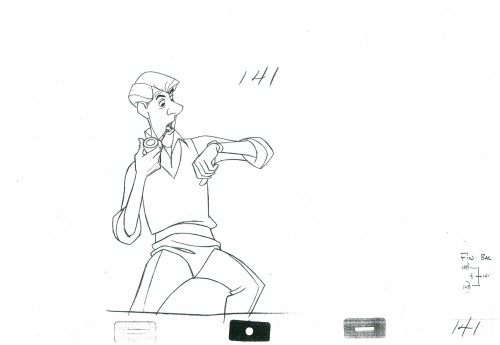
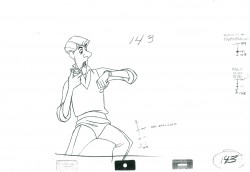
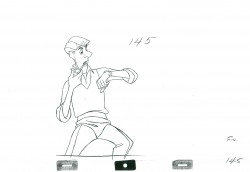
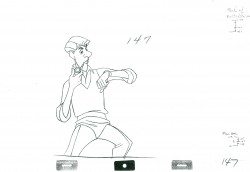
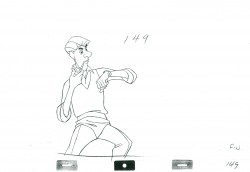
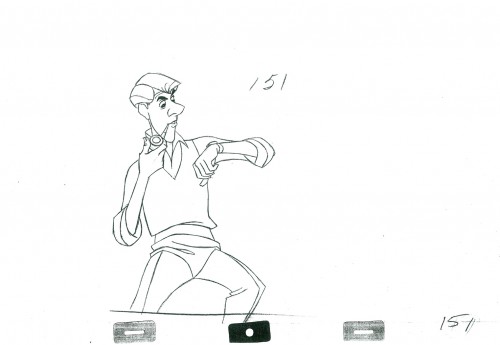
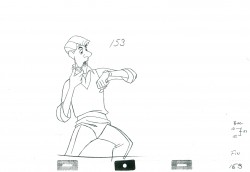
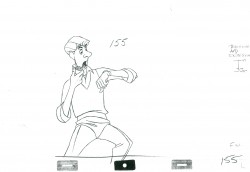
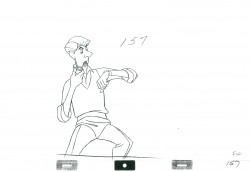
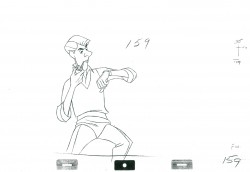
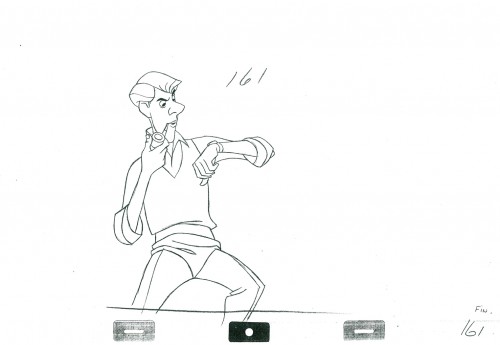
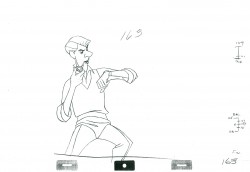
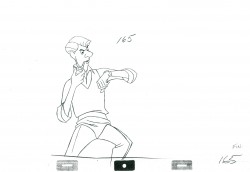
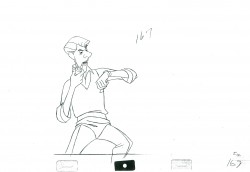
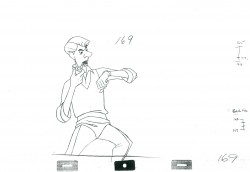
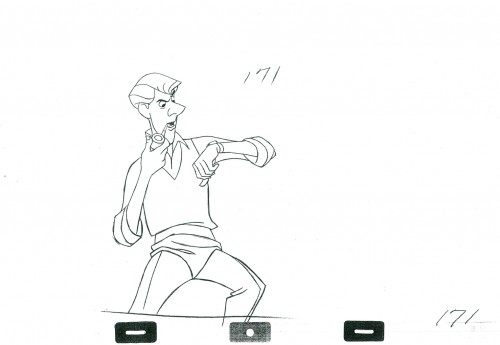
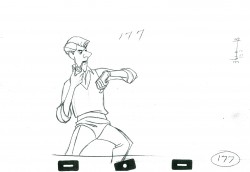
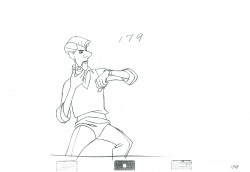
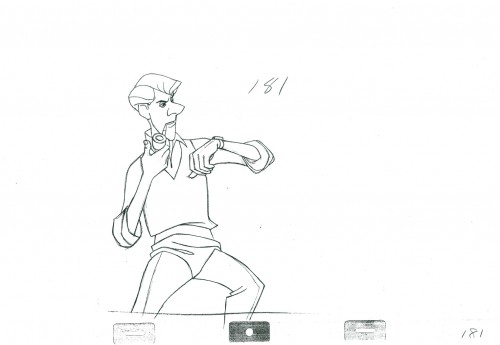
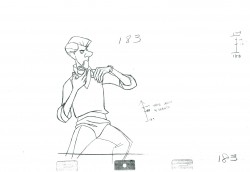
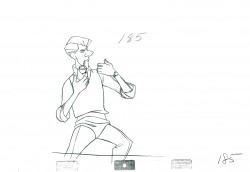
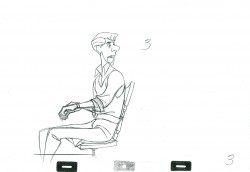
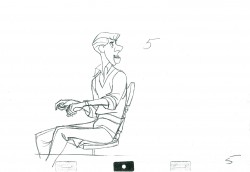
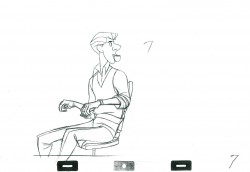
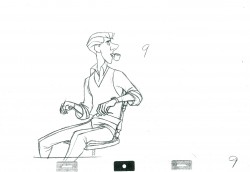
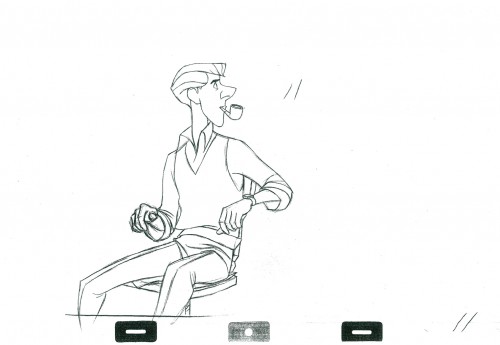
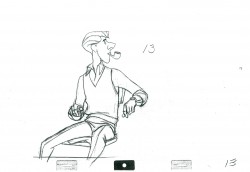
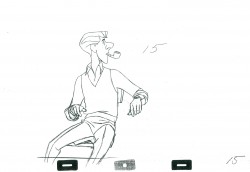
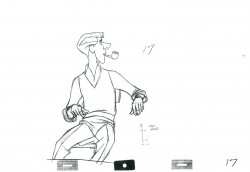
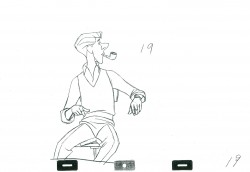
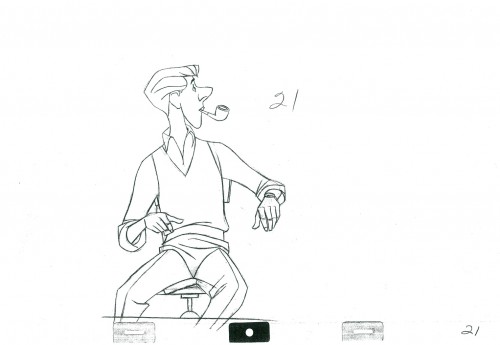
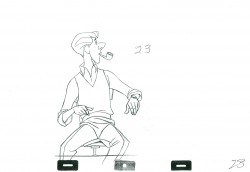
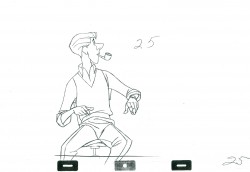
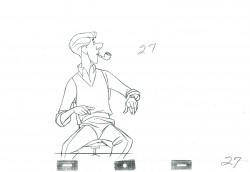
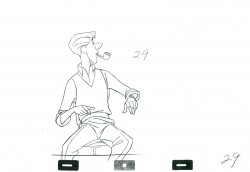
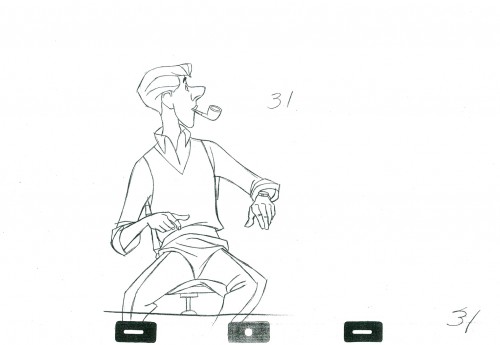
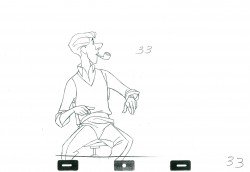
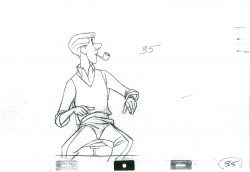
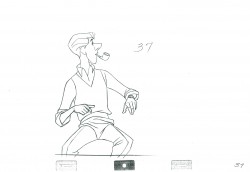
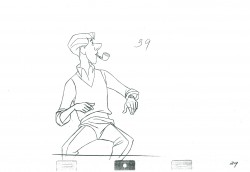
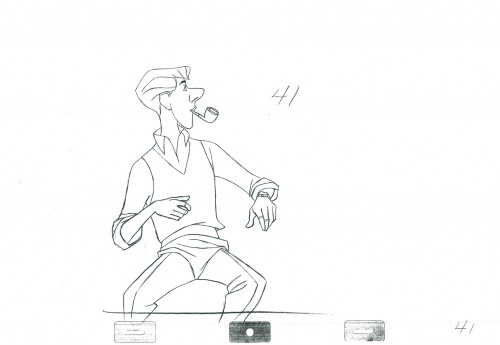
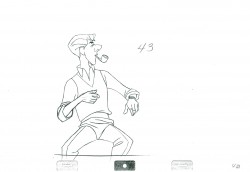
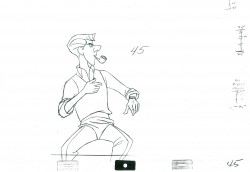
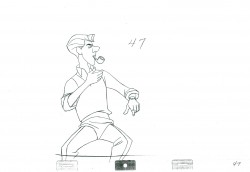
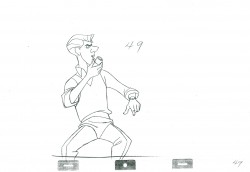
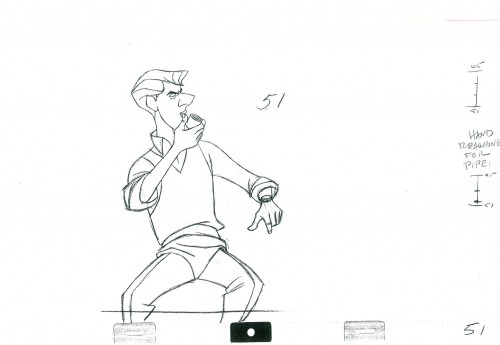
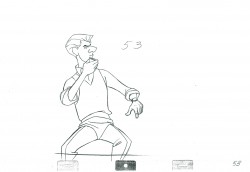
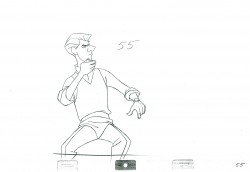
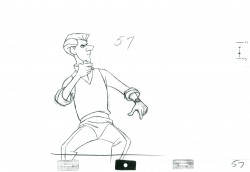
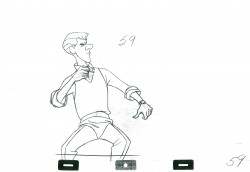
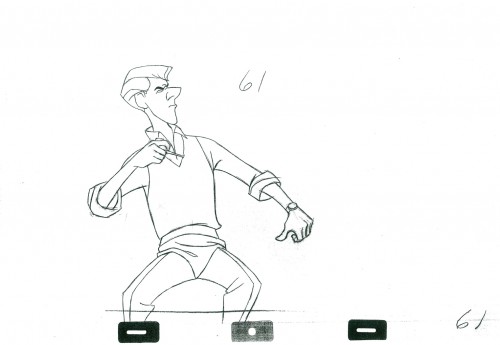
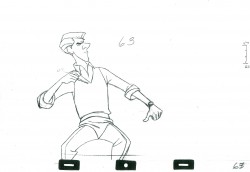
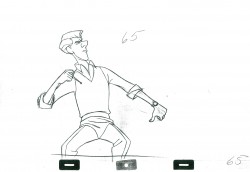
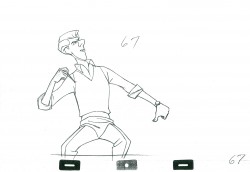
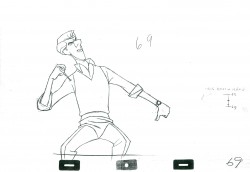
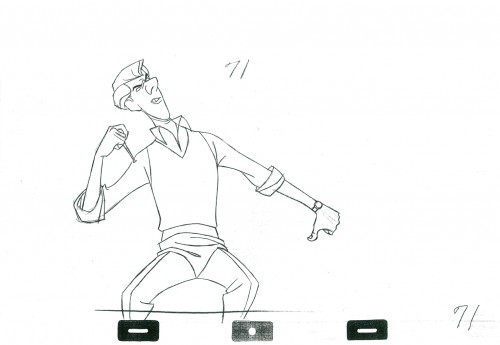
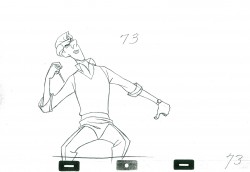
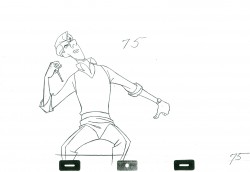
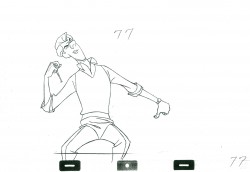
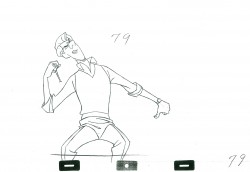
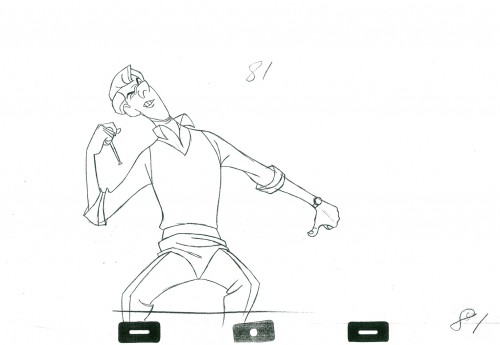
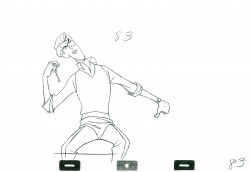
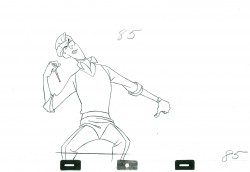
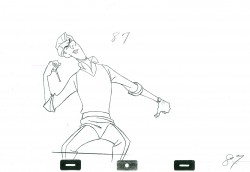
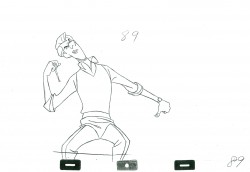
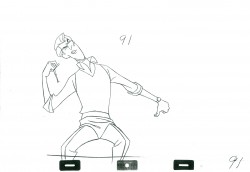
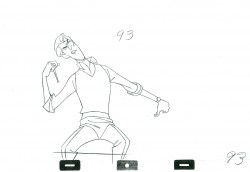
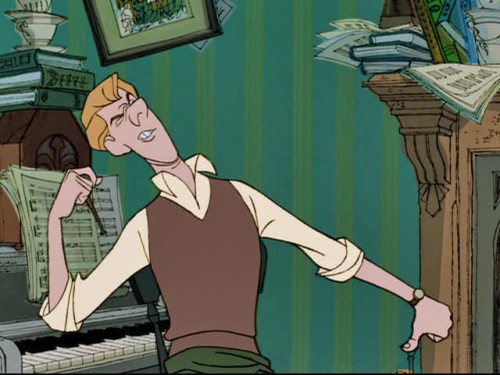
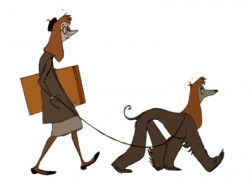 1
1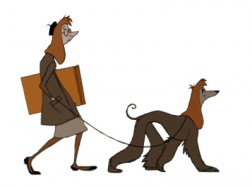 2
2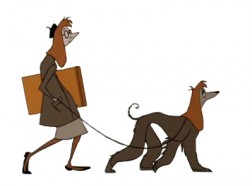 3
3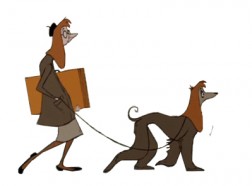 4
4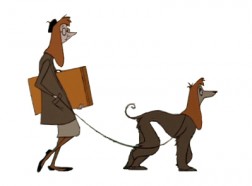 5
5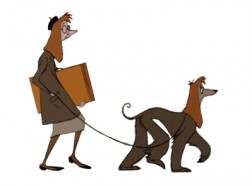 6
6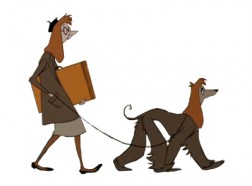 7
7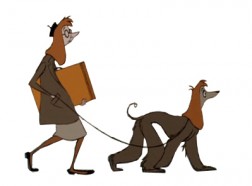 8
8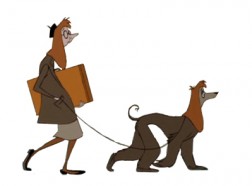 9
9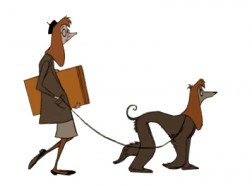 10
10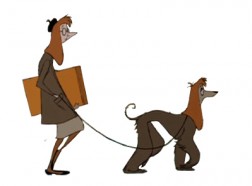 11
11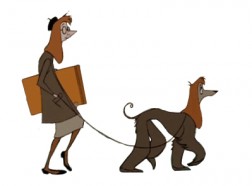 12
12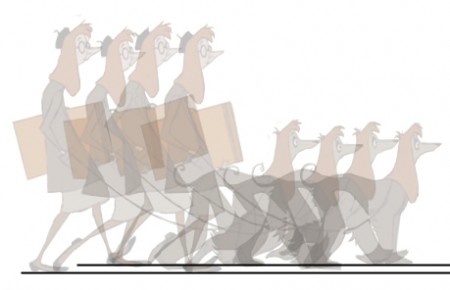
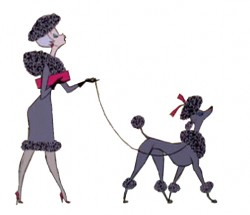 1
1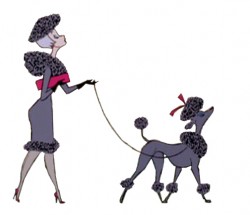 2
2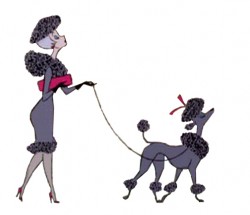 3
3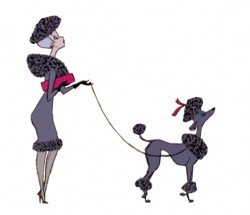 4
4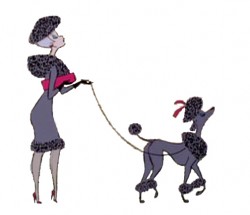 5
5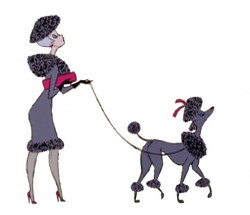 6
6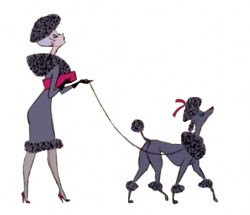 7
7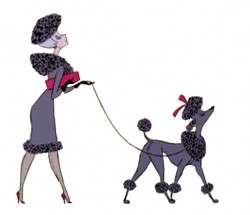 8
8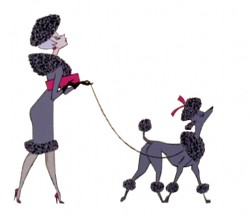 9
9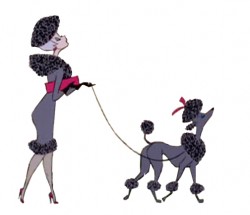 10
10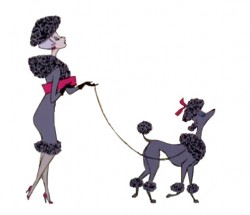 11
11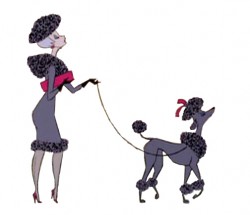 12
12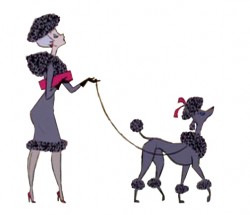 13
13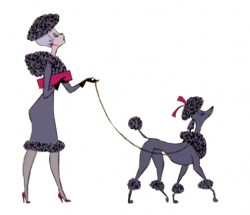 14
14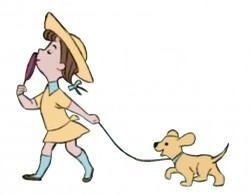 3
3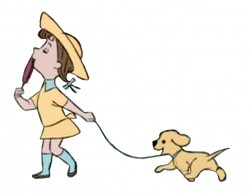 4
4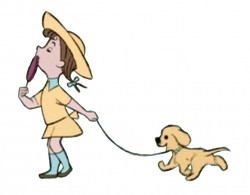 5
5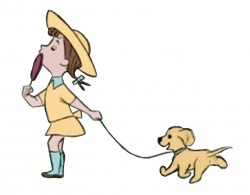 6
6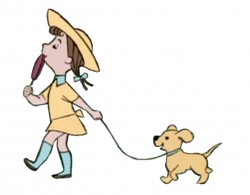 7
7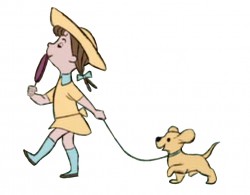 8
8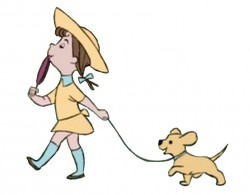 9
9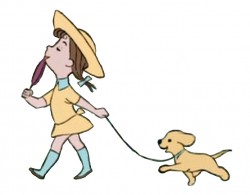 10
10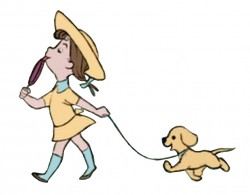 11
11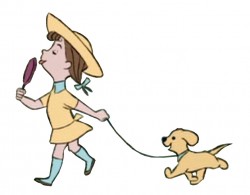 12
12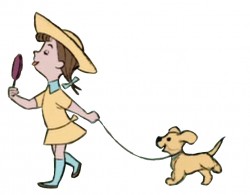 13
13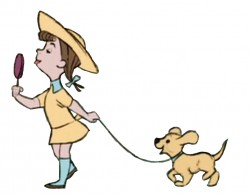 14
14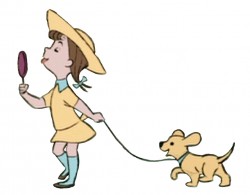 15
15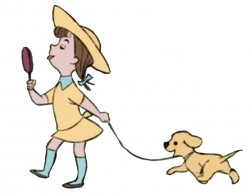 16
16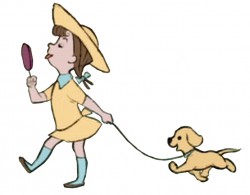 17
17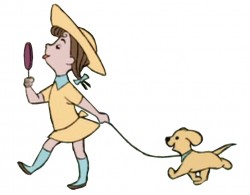 18
18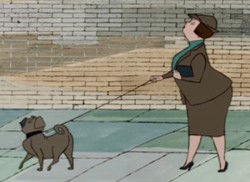 1
1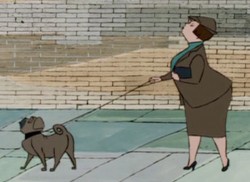 2
2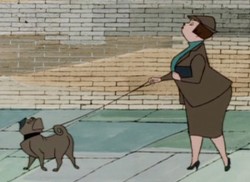
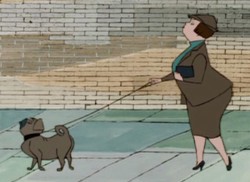 4
4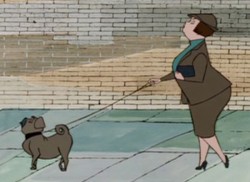 5
5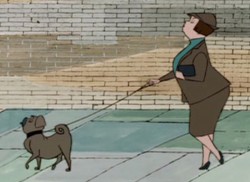 6
6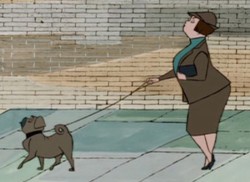 7
7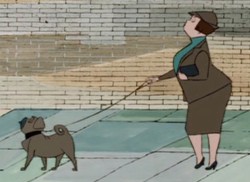 8
8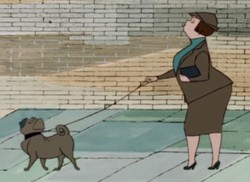 9
9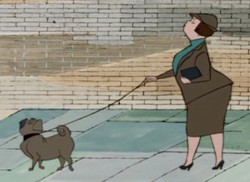 10
10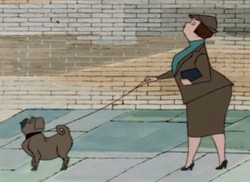 11
11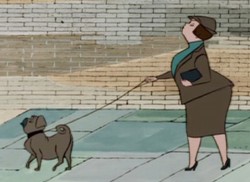 12
12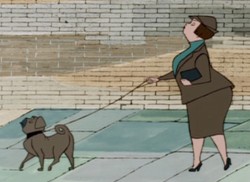 13
13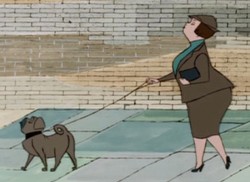 14
14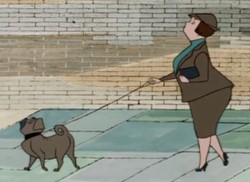 15
15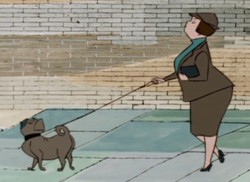 16
16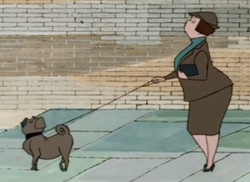 17
17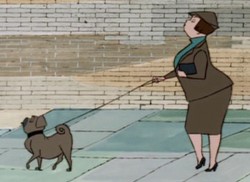 18
18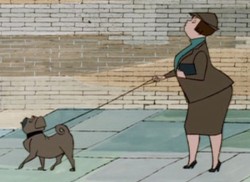 19
19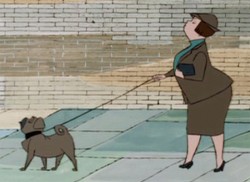 20
20